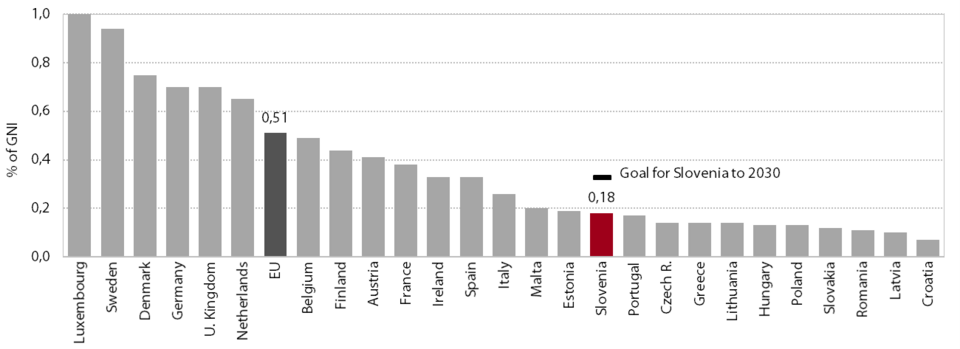Development Report
Related Files:
Development Report 2018
Back on track to convergence with more developed Member States, Slovenia has been moving towards an inclusive society in the last few years; it has also reduced pressures on the environment. In certain areas developments have deviated significantly from the principles of sustainable development and pose a risk to the achievement of the SDS’s primary objective. To achieve the SDS’s central goal, it is essential to ensure more sustainable development by balancing its economic, social and environmental components.
Related Files:
Recommendations for development policies:
- Acceleration of productivity growth for economic progress and higher living standards.
- Adjustment to demographic change to ensure a decent life for all and long-term sustainability of public finances.
- Transition to a low-carbon circular economy to reduce the environmental burden and enhance the competitiveness of the economy.
- Increase in the efficiency of the government and its institutions to support and promote development.
Slovenia's development - Indicators:
- A highly productive economy creating value added for all
- Lifelong learning
- An inclusive, healthy, safe and responsible society
- A preserved healthy natural environment
- A high level of cooperation, training and effective governance
1. Gross domestic product per capita in purchasing power standards
In 2016 Slovenia reduced slightly its economic development gap vis-à-vis the EU average for the first time since 2008. In 2008 its GDP per capita in PPS reached 90% of the EU average, but during the economic crisis, particularly in 2009, it fell considerably more than in the EU as a whole, so that Slovenia’s development gap had widened to 18 pps by 2012. Only in 2016 did Slovenia improve its position relative to the EU average, this by 1 pp (with GDP at 24,100 PPS ). Data on economic activity in 2017 show that Slovenia continued to converge with more developed EU Member States last year, a trend that can also be expected in the years to come. A breakdown of per capita GDP into productivity and employment rate shows that the widening of the gap was more affected by the fall in employment. Slovenian employment rates, which were significantly above the EU average at the onset of the crisis, have thus stabilised just above the average rate in the EU. Although the productivity gap widened less during the crisis, its level is still considerably below the EU average, pointing to an area that is crucial for closing the overall development gap.
Slovenia remains one of the EU countries that have seen their relative positions in terms of economic development deteriorate the most since the beginning of the crisis. Only six Member States have diverged more from the EU average since 2008: Greece (25 pps), Cyprus (22 pps), Finland (12 pps), the Netherlands (11 pps), and Spain and Italy (9 pps each). Fourteen countries have narrowed their gaps, ten of them being new Member States. Two Member States, Malta and the Czech Republic, have overtaken Slovenia in this period. The overall gap in per capita GDP in PPS between the most and the least developed EU Member States has narrowed from 1:8.7 in 2000 (Romania/Luxembourg) to 1:5.3 in 2016 (Bulgaria/Luxembourg).
Figure: GDP per capita and its components
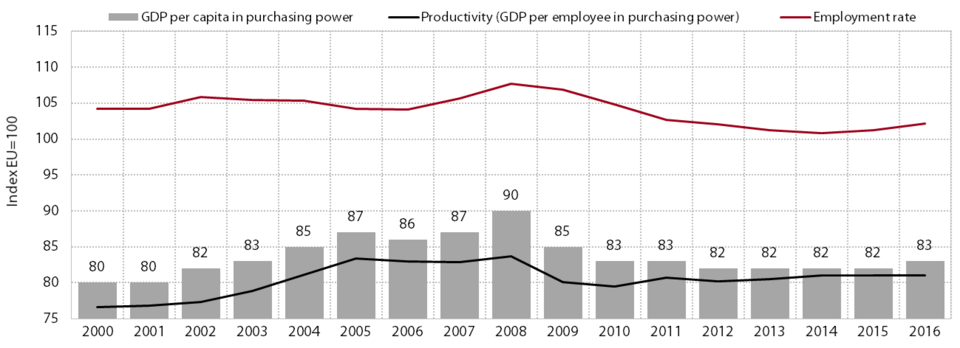
2. General government debt
After increasing significantly in 2008–2015, general government debt as a % of GDP has since been declining. Slovenia’s indebtedness, which until 2008 had been very low, surged in deteriorated macroeconomic conditions owing to several years of persistently high general government deficits and the impact of one-off expenditures (mostly bank recapitalisations and payments on the basis of court decisions). Since 2015, when it peaked at 82.6% of GDP, the debt-to-GDP ratio has been falling due to the improvement in the primary balance (surplus); moreover, in the last two years, the positive contribution of economic growth exceeded the negative effect of interest expenditure on debt formation, thus eliminating the unfavourable "snowball effect". At 73.6% of GDP, Slovenia’s debt is still significantly above the 60% limit set in the Stability and Growth Pact, but the dynamics of its reduction in 2016 and 2017 comply with the Pact’s rules for the three-year transition period following the abrogation of the excessive deficit procedure. Slovenia has taken advantage of the favourable financial market conditions in recent years to buy back dollar-denominated bonds issued in 2012–2014, when it had limited access to financial markets, and to pre-finance the liabilities of the state budget, thus creating some liquidity reserves. Active debt management contributed to both a decline in interest on the existing debt and a lengthening of the average debt maturity. The implicit interest rate has thus fallen to new lows in the last few years (3.4% in 2017). The improved fiscal position has also played a significant role in the improvement of Slovenia’s credit ratings in recent years, though these remain worse than before the crisis.
Figure: Consolidated general government debt as a share of GDP in 2017 and change in the share of debt in 2008–2017
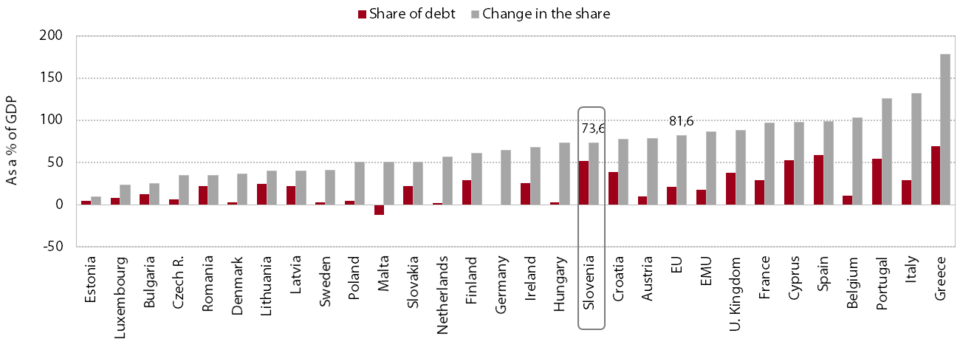
3. Real GDP growth
After four years of growth, GDP exceeded its pre-crisis peak in 2017; in the last two years its growth has strengthened further, supported by export growth momentum and stronger growth in domestic consumption. After the double-dip recession, Slovenia’s real GDP has been rising since 2014, its growth becoming more broad-based and closer to the rates from before the 2007 peak. The main driver of growth remains exports. Their growth has been strengthening further in the last few years, driven by stronger growth in foreign demand and a concurrent improvement in the export competitiveness of Slovenian enterprises, which is reflected in rising export market share on the global market. Domestic consumption has also become an increasingly important driver of growth: until 2016, household consumption in particular, which rebounded at the end of 2013 and continues to be boosted by favourable labour market conditions and high consumer confidence, and since 2017, also investment in gross fixed capital formation, though this is still significantly lower than before the crisis due to its sharp fall in the early years thereof (2009–2012). Private investment in machinery and equipment has otherwise been steadily rising since 2014, which is mainly related to high capacity utilisation, good business performance and low corporate indebtedness. Residential investment rebounded in mid-2016, while last year renewed growth was also recorded for investment in civil-engineering works. With a gradual relaxation of austerity measures, government consumption also expanded in the three years to 2017.
After a sharper fall during the crisis, Slovenia recorded faster GDP growth (5.0%) than the EU average (2.4%) in 2017 for the fourth year in a row. This was primarily a consequence of Slovenian exports rising faster than those of the EU as a whole, where in recent years GDP has been almost equally driven by exports and domestic consumption. Last year Slovenia’s GDP growth also outpaced the average of other new Member States, where GDP has increased at stable rates ever since 2010 and behind which Slovenia still lags significantly in terms of cumulative growth in the period since 2005.
Figure: GDP in Slovenia, the EU and selected groups of EU Member States
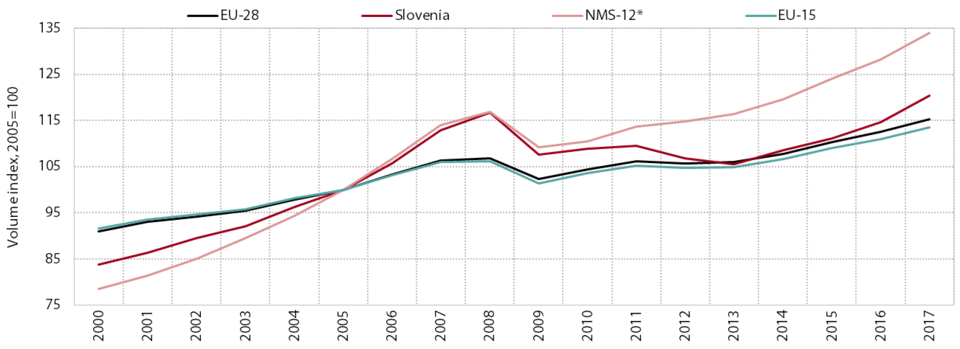
4. General government balance
The general government balance has improved significantly over the last few years. The general government deficit has been steadily declining since 2013, when it was at its highest, partly under the impact of one-off factors. In 2017 the budget was balanced. This was attributable to the improvement in macroeconomic conditions as a result of the stabilisation of the banking sector and restored domestic and international confidence, the adoption of measures to increase revenue and contain expenditure, and lower capital transfers related to BAMC transactions. Most of the measures for increasing revenue after 2013 were of a permanent nature. They included increases in the rates of certain existing taxes and the introduction of new taxes and a broadening of the base for social contributions; the government also stepped up activities for more efficient tax collection (introduction of tax registers). These measures have also partly offset the loss of revenue from corporate income tax resulting from both weaker business performance during the economic crisis and reductions in the rate of corporate income tax between 2006 and 2016, which contributed to fiscal consolidation and a decline in the structural deficit. The changes also shifted the tax burden from capital to consumption during the crisis, while the effective taxation of labour remained more or less unchanged. In the last two years, the government has adopted certain measures for restructuring public taxes to lower the tax burden on labour and increase the tax burden on capital. On the expenditure side, particularly employee compensation and social benefits and transfers fell in 2012–2014, this as a result of austerity measures adopted in 2012, but since 2014 these measures have been gradually relaxed. The containment of total expenditure was to a great extent attributable to a significant decline in investment and subsidies over the 2008–2017 period, which points to the great role played by flexible expenditure in the consolidation process thus far. As a result of favourable borrowing terms and active debt management, interest payments have also been falling since 2015, but owing to the rising debt, their share in total expenditure remains high (5.8% of total expenditure in 2017 compared with 2.5% in 2008).
Figure: General government balance, 2017
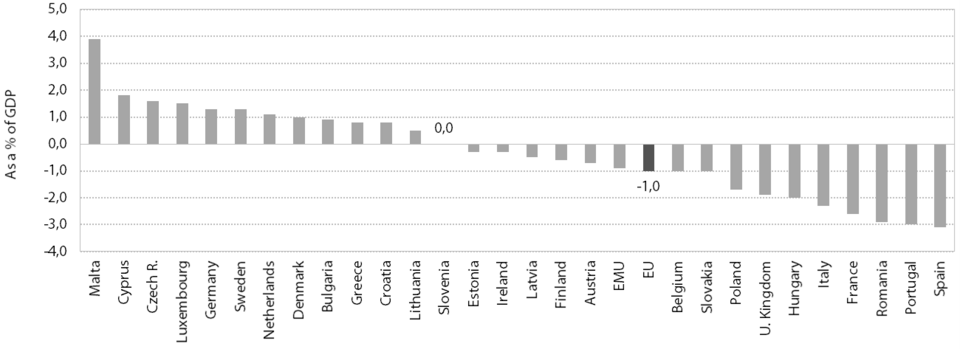
5. Current account of the balance of payments and net international investment position
The surplus on the current account of the balance of payments in 2017, at EUR 2.8 billion (6.4% of GDP), was the highest recorded to date. The current account, which remained more or less balanced in the first two years of the economic crisis, has recorded a surplus since 2011, widening by EUR 2.7 billion in 2012–2017 as a whole. The surplus in current transactions is a consequence of: (i) private sector deleveraging and net savings and (ii) improvement in the competitive position of Slovenian exporters and the still low level of investment. The current account surplus also reflects the lower deficit in current transactions of the government sector, which is mainly a consequence of positive changes in the fiscal balance, i.e. a reduction in the general government deficit. The excess of aggregate savings over investment is reflected in both a decline in external liabilities and an increase in international financial assets, meaning that Slovenia’s international net investment position is improving.
After the liberalisation of the capital and financial accounts and Slovenia’s accession to the EU, the net financial position vis-à-vis the rest of the world turned from positive to negative. Despite private sector deleveraging, it deteriorated significantly in the first years of the crisis (until 2012) owing to increased government borrowing. Since 2013 it has been gradually improving, primarily as a result of further deleveraging by commercial banks, lower government liabilities to foreign portfolio investors and higher banking sector external claims. Commercial banks and the Bank of Slovenia are stepping up financial investment in foreign securities, which is a consequence of developments in financial markets, i.e. low or negative interest rates on the money market. The Bank of Slovenia is also buying securities under the asset purchase programme (APP). In the last few years external liabilities have been rising only in the direct investment component, this owing to a larger stock of inward FDI, which is increasingly exceeding the stock of outward FDI. Despite the increase in this negative position, the structure of the overall net international investment position is therefore more favourable than in previous years. In 2017 Slovenia recorded a negative net financial position of 31.3% of GDP, which is within the indicative threshold of external imbalances (35% of GDP). This threshold is exceeded most markedly by the countries that experienced the severest sovereign debt crises (Spain, Portugal, Cyprus, Greece and Ireland).
Figure: Breakdown of changes in the net financial position, in EUR million
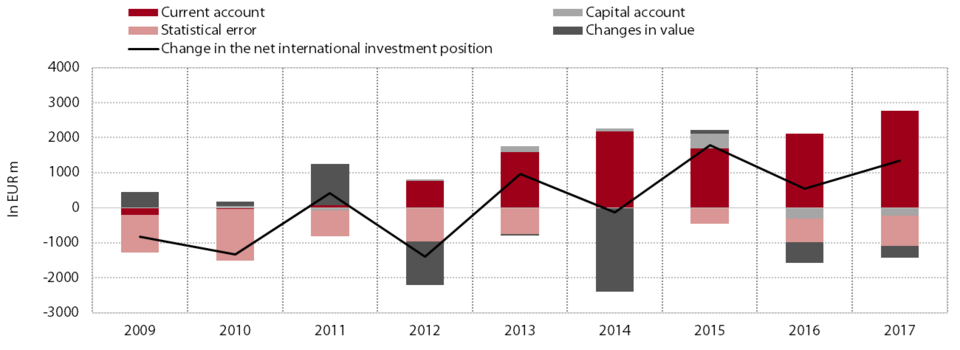
6. Financial system development
Slovenia has a wide gap with the EU average in financial system development; particularly the gap in capital market and banking sector development has widened since the onset of the crisis. The situation in the financial system is gradually improving, particularly as regards sources of finance, while the quality of the banks’ assets also continues to improve (at the end of 2017 the share of arrears of more than 90 days was 3.7%, having peaked in 2012 at 14.4%). The gap with the EU average as measured by the indicator of the banks’ total assets relative to GDP is widening, however. Following the intense corporate deleveraging in banks, the volume of corporate loans was considerably lower than in 2008 despite the increase in 2017 (the first since 2010). This was also reflected in the movement of the banking system’s total assets, which had been declining since 2010 until rising slightly last year. However, as this increase did not follow the growth of GDP, the indicator of total assets as a share of GDP dropped further last year and was more than one quarter (27.7%) lower than at the end of 2008 (larger declines being reported only for Ireland, Austria and Malta). On the asset side, the decline in the banks’ total assets since 2010 has been largely due to the falling volume of loans to non-banking sectors as a result of corporate deleveraging; on the liability side, the banks drastically reduced their liabilities to foreign banks (by almost 90% to EUR 2.0 billion), including the ECB (liabilities to the ECB started to decline after the banks’ balance sheet repair at the end of 2013). This source of funding was only partly offset by non-banking sector deposits, and the maturity structure of these is fairly unfavourable, with overnight deposits accounting for almost two-thirds. Slovenia has the widest gap with the EU average in terms of its capital market. Never a significant source of financing for the Slovenian economy, the capital market has shrunk further and markedly since 2007. The market capitalisation of shares remains low even in favourable economic conditions. The number of stocks listed on the Ljubljana Stock Exchange continues to fall, there being practically no new issues, and trading volume remains extremely low. The largest segment of Slovenia’s capital market is bonds (more than 80%), where government bonds predominate (97%).
The gap with the EU is smallest in the insurance sector, where the indicator value also dropped the least relative to the pre-crisis period. However, Slovenia still lags significantly behind the EU in the share of life-insurance premiums, which, at 1.4% of GDP, is less than one-third of the EU average. The low value of premiums in this insurance category is mainly a consequence of the relatively insignificant level of saving for old age, which additionally impedes capital market development.
Figure: Banks’ total assets as a % of GDP in EU Member States, 2016

7. Regional variation in GDP per capita
GDP per capita is highest in the Osrednjeslovenska region, which exceeds the national average by more than 40%. This is partly, however, a consequence of high commuter flows, as Osrednjeslovenska is the region that provides the most (over one-third of) jobs. The only other region to exceed the Slovenian average in GDP per capita is Obalno-kraška. GDP per capita is lowest in Zasavska, at just above 50% of the Slovenian average. Since 2016 GDP has again been rising across all regions. From 2014 it was already growing relatively fast particularly in the regions of Zahodna Slovenija, i.e. those that also recorded relatively larger declines in economic activity in the first years of the crisis. In 2015 and 2016 the strongest GDP growth was recorded in the Obalno-kraška region; it was also strong in the Osrednjeslovenska and Gorenjska regions. In the last few years, below-average growth has again been seen in most Vzhodna Slovenija regions, which are also among the least developed.
Regional disparities, which are small in Slovenia compared with other countries, decreased further during the crisis. The relative dispersion of GDP per capita, which is one of the indicators of regional disparities, had been decreasing from 2010 to 2015; in 2016 it rose slightly, but remained lower than before the crisis (21.7% compared with 22.3% in 2008). This is mainly attributable to a larger fall in economic activity in most of the relatively more developed regions during the crisis, and although since 2014 their GDP has again been rising faster than in other regions, the disparities between the regions are still smaller than they were before the crisis. The ratio between the two regions with the highest and lowest values of per capita GDP (1:2.6) is also relatively small compared with other EU Member States, though it is gradually rising.
The gap between the regions and the EU average in GDP per capita, which had mostly been widening during the crisis, has narrowed since 2014. Zahodna Slovenija was at 97% of the EU average in 2016 (109% in 2008), while Vzhodna Slovenia was at 67% (74% in 2008) and thus remained among the less developed regions in the EU. The Osrednjeslovenska region is the only statistical region to exceed the EU average, but its advantage decreased significantly from 2008 to 2016 (by 15 pps, which represented the greatest deterioration among the Slovenian regions). Besides Osrednjeslovenska, Obalno-kraška and Zasavska increased their gaps with the EU average the most in this period (−11 pps); Zasavska is otherwise also the region with the greatest lag.
8. The development risk index
The composite development risk index (DRI) value, calculated on the basis of data available in 2017, is highest in the Pomurska and lowest in the Osrednjeslovenska region. Pomurska (index value 163.8) has the lowest results for as many as seven indicators. This region also ranks last but one in terms of per capita GDP. Osrednjeslovenska has the highest or among the highest values for most indicators, except for investments in fixed assets as a share of GDP and the proportion of protected areas, where its values are somewhat lower, though still above average. The region closest to the average is Goriška.
Relative to 2014, the DRI value declined the most in Koroška and increased the most in Posavska. Compared with 2014, when DRI values were calculated for the entire programming period 2014–2020, the index value fell the most in Koroška (by 8 index points). It also dropped in Podravska, Goriška and Savinjska, while remaining unchanged in Primorsko-notranjska. In all other regions it rose, the most in Posavska (by 9 index points), mainly as a consequence of lower values of investments in fixed assets, disposable income, unemployment of young people and the proportion of protected areas. This region nevertheless remains sixth according to its DRI value, which is where it was in 2014. The rankings in terms of the DRI otherwise have not changed significantly from year to year.
A comparison of the regions’ rankings according to the DRI and GDP per capita shows the greatest differences in the Gorenjska and Obalno-kraška regions. The DRI has been introduced into regional policymaking because GDP per capita proved to be too narrow an indicator to capture the multi-dimensional nature of regional development. The two indicators are otherwise not mutually comparable in absolute terms, as the DRI includes as many as 14 indicators from different areas. The rankings on the two indicators differ the most in the Gorenjska and Obalno-kraška regions. Gorenjska is the region with the second lowest risk to development (after Osrednjeslovenska), though ranking only sixth in per capita GDP; this is related mainly to its low unemployment and high employment rates, above-average productivity, high disposable income per capita, and relatively favourable score on the population ageing index.
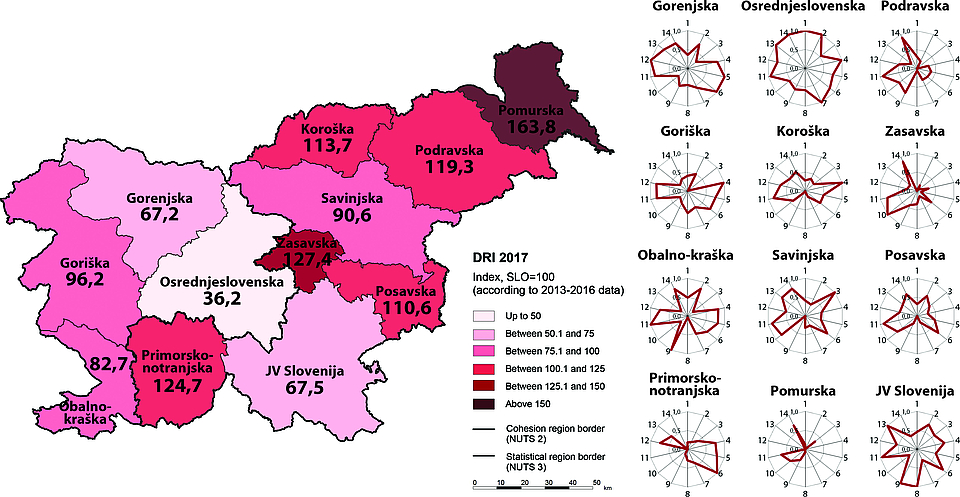
9. Productivity
Slovenia’s productivity gap with the EU average remains wider than before the crisis. The SDS goal is to reach 95% of the average productivity level in the EU by 2030 (it stood at 81% in 2016). Over the comparably long period of 2000 to 2016, Slovenia reduced its productivity gap by only 4 pps. The dynamics of convergence, however, varied during this period. Until the onset of the crisis, productivity had been rising faster than the EU average, Slovenia thus achieving its smallest lag behind the EU in 2008 (84% of the average). The economic crisis then wiped out most of the progress made, the slowdown in productivity growth being a consequence of more pronounced cyclical and structural factors. In the last few years Slovenia has again been gradually catching up with the EU average, though at a much slower pace than before the crisis. Trend productivity growth in 2016 and 2017 reached only a good third of that in 2000–2007, mostly as a consequence of the absence of capital deepening.
Productivity movements are unfavourable particularly in the non-tradable sector. In the tradable sector, they are significantly influenced by manufacturing, which is the most exposed to competition. Manufacturing has relatively rapidly offset productivity losses incurred during the crisis, and since 2013 its productivity has mostly been rising faster than elsewhere in the EU. On the other hand, the non-tradable sector still lags behind pre-crisis levels in terms of productivity and has seen its already wide gap with the EU average widen further. This can be attributed to construction, as this sector was severely affected by the crisis, and to certain knowledge-intensive services (such as financial and professional and technical services) that are focused predominantly on the domestic market, where demand started to recover later and more slowly than foreign demand. Following a long period of mainly negative trends, productivity in these non-tradable sector activities, particularly construction, increased more markedly in 2017.
Figure: Productivity of the economy (GDP per employee in PPS) and real productivity growth (value added per employee) in the tradable and the non-tradable sectors
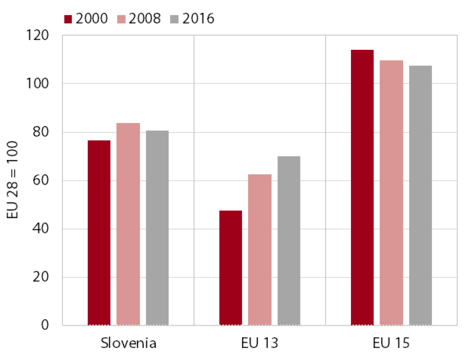
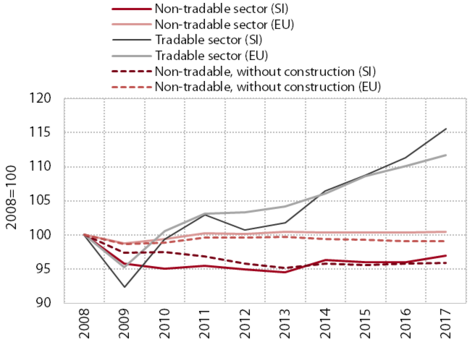
10. The European Innovation Index
Slovenia was close to the EU average in terms of the European Innovation Index (EII) in 2010–2016, but its convergence stagnated. The EII is a composite indicator measuring performance of national innovation systems in EU Member States in four areas: (1) framework conditions for the innovation activity of enterprises, (2) investment in innovation activity, (3) innovation activity at the level of enterprises and (4) impacts of innovation activity of enterprises. Based on the EII, countries are classified into four performance groups from the most to the least innovative. Slovenia is in the group of strong innovators with EII values between 90% and 120% of the EU average. During the crisis, the EII value deteriorated or stagnated in half of the EU Member States, including Slovenia. The group of those that increased their EII values during that period meanwhile included both some of the innovation leaders and countries from other groups. In 2010–2016, the gap between the Member States with the best and the worst performance with regard to the EII (Sweden and Romania) widened further.
Slovenia’s innovation system is relatively strong in framework conditions, which affect the innovation activity of enterprises, while it is relatively weakest regarding investments in innovation activity and their effects. Regarding framework conditions, in 2010–2016 Slovenia made the greatest progress in the number of new doctors of science, the percentage of the population aged 25–34 having completed tertiary education, international scientific co-publications and scientific excellence. The share of enterprises with access to high-speed broadband – which is a condition for introducing advanced electronic and mobile services – also increased significantly. The greatest weaknesses are revealed in investment in innovation activity related to both the reduction of public R&D expenditure and the low level of venture capital investments, which are usually oriented towards high-growth high-technology enterprises. Slovenia is also relatively weak in terms of the effects of innovation activity on competitiveness, which is reflected particularly in the low shares of exports of knowledge-intensive services (see Indicator 1.14) and persons employed in high-growth enterprises.
Figure: European Innovation Index, expressed relative to the EU average (EU 2010=100)
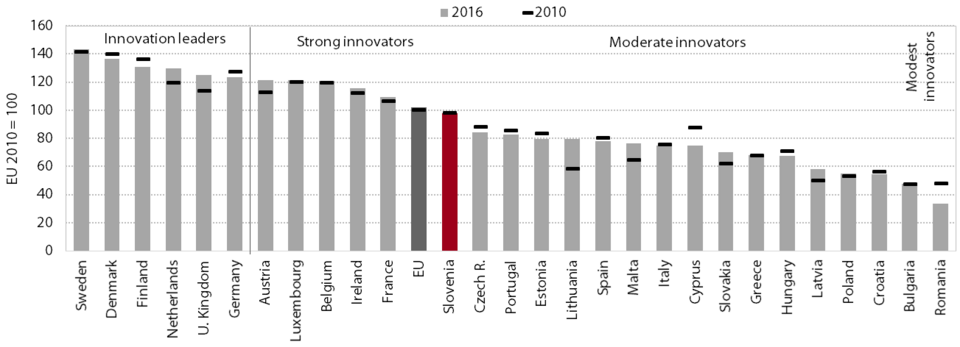
11. The Digital Economy and Society Index
Slovenia belongs to the group of medium-performing EU Member States regarding the digital transformation of the economy and society; its ranking has not changed significantly since 2014 measurements began. The index monitors the evolution of EU Member States in terms of digital competitiveness, measuring their progress in five dimensions: connectivity, human capital, use of internet services, integration of digital technology and digital public services. Slovenia ranks slightly below the EU average in terms of the digital transformation of the economy and society, lagging behind in four of the five index components, the most in the use of internet services (23rd place in 2017). Throughout this period, the internet has been relatively widely used for simpler services (news, music, games, videos, etc.) but considerably less than generally in the EU for more advanced services such as e-banking and online shopping. In the last few years, social networks have also been used significantly less than in the EU. The integration of digital technology is the only index component where Slovenia has made visible progress in the last few years and exceeded the EU average (7th place). It ranks above or close to the EU average on most business digitisation and e-commerce indicators. Since 2015 – when e-invoicing became mandatory for all suppliers of budgetary users – a rapid introduction of e-invoices in a standard format stands out in particular in this regard. In connectivity, a slow transition to mobile and fast broadband has been observed; the coverage of the latter is good, but prices remain relatively high. In the human capital dimension, Slovenia lags slightly behind the EU in the percentage of internet users and in basic digital skills. The shares of ICT specialists in the workforce and of science, technology, engineering and mathematics graduates, the two indicators of advanced digital skills, are similar to those in the EU overall. In digital public services Slovenia lags behind the EU average particularly due to its smaller share of population interacting with public administration completely by electronic means. At the same time, it ranks around the EU average on most indicators of the supply of e-government services, where of late considerable progress has been made particularly with regard to open data and the extent to which administrative procedures related to important life events can be performed completely online.
Figure: Digital Economy and Society Index (DESI) and its components, 2017
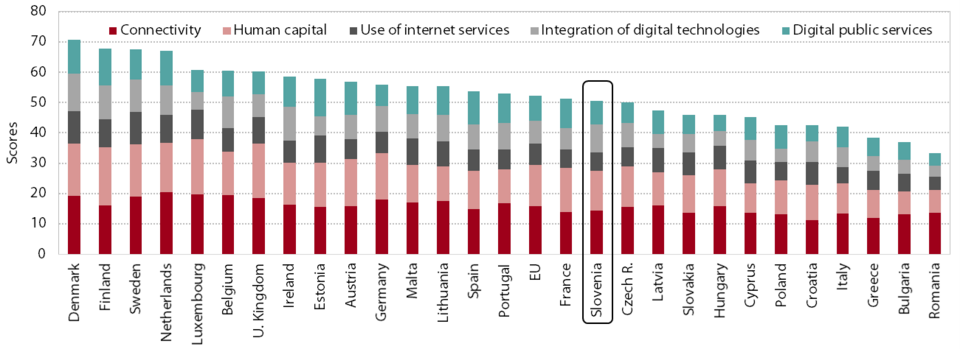
12. Export market share
The export share of Slovenian goods on the world market is approaching the level of its pre-crisis peak. The presence of Slovenian goods on foreign markets peaked in 2007, when Slovenia satisfied approximately 0.2% of global demand for goods. In 2008–2012, however, Slovenia was one of the EU countries with the largest market share declines on the global market, which was also partly due to the regional orientation of its exports. Since 2013 Slovenia’s market share has again been rising; it has already exceeded pre-crisis levels in the EU and most main trading partners, while being still somewhat lower on the global market. In 2017 the positive trends continued. Market share in the EU, where Slovenia exports around three-quarters of its goods, grew by 5.1% (3.1% in 2016). The greatest contribution to export market share growth was made by exports to France. Among main trading partners outside the EU, market share increased in Switzerland, Turkey and the US and declined in countries of the former Yugoslavia and in Russia. According to preliminary data, Slovenia’s total export market share on the global market rose by 7.4% in 2017 (8.0% in 2016).
Broken down by product groups, the market share of high-technology products rose the most over the longer term. With an increase in the relative importance of high-technology products and a decline in the share of low-technology products, the product composition of Slovenia’s exports came closer to that of the EU as a whole. In the period since 2000, the market share of natural resources has also been rising relatively rapidly (owing mainly to rising wood exports and international trade in oil), but Slovenia satisfies only a relatively small share of the world’s natural-resource demand. Among manufactured goods, in 2017 the market share in the EU increased the most in road vehicles (by almost 15%), mainly on account of the start of production of a new car model last year. Without the contribution of road vehicles, manufacturing activities would have seen much lower market share growth in the EU in 2017, yet still higher than in 2016. In 2017 strong market share growth in the EU was also recorded for medicinal and pharmaceutical products and, to a lesser extent, electrical machinery and equipment. These being the three main product groups of Slovenian exports, product specialisation of exports increased further. The largest market share declines were recorded for iron and steel and non-ferrous metals, where Slovenia's (otherwise relatively high) export growth did not follow the strong increase in import demand.
Figure: Change in global export market shares, EU countries
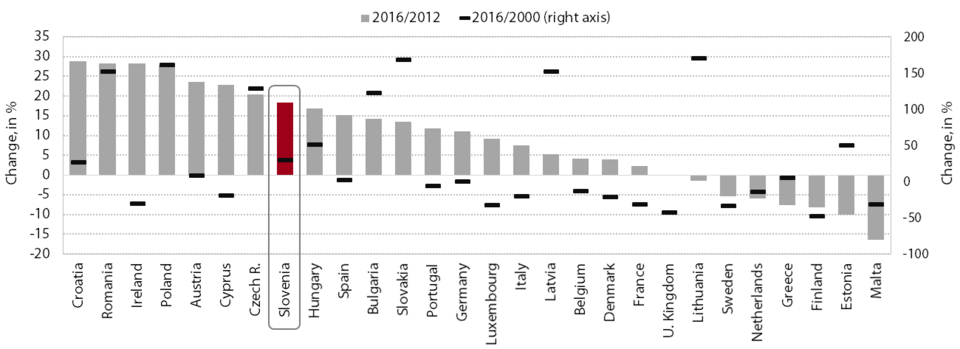
13. Unit labour costs
Slovenia has been gradually closing the competitiveness gap with the EU that opened in the period of the crisis. Under the impact of strong wage growth (in 2008 and 2010) and a decline in productivity (2009), Slovenia saw a significant deterioration in its cost competitiveness relative to the EU during the crisis. This gap has since mostly been narrowing, in 2012 and 2013 solely on account of labour market adjustment (a decline in compensation of employees). In 2017 developments were much more favourable, with the cost competitiveness of the Slovenian economy improving further as a result of stronger growth in productivity, which outpaced the growth of wages. In the EU, average unit labour costs remained unchanged in 2017 for the second consecutive year, albeit with significant differences between Member States (in terms of both level and dynamics). A significant increase in unit labour costs is mainly recorded for new Member States, where unit labour costs were previously among the lowest.
In the tradable sector, unit labour costs are declining at a faster pace than in the non-tradable sector, which is also a consequence of labour market adjustments, but in the future it will be crucial to accelerate productivity growth. The decline in unit labour costs has a favourable impact on competitiveness particularly in the tradable sector, but also – indirectly – in the non-tradable sector (for example through lower prices of services). Unit labour costs in Slovenia’s non-tradable sector still exceed their pre-crisis level (by 4.7%), while in the tradable sector their movements have been more favourable (a decline of 1.4% on 2008), given that in manufacturing and traditional market services (accommodation and food service activities, trade, and transportation), compensation per employee has been rising more slowly than productivity since the crisis. Although the growth of tradable sector productivity strengthened in 2017 (3.8%), it is still lower than the long-term average before the crisis (5.2%). Amid the expected upward pressures on wages, a further strengthening of productivity growth will be crucial to maintain the competitive position in the future.
Figure: Unit labour costs in the tradable sector, EU Member States, change in 2015–2017
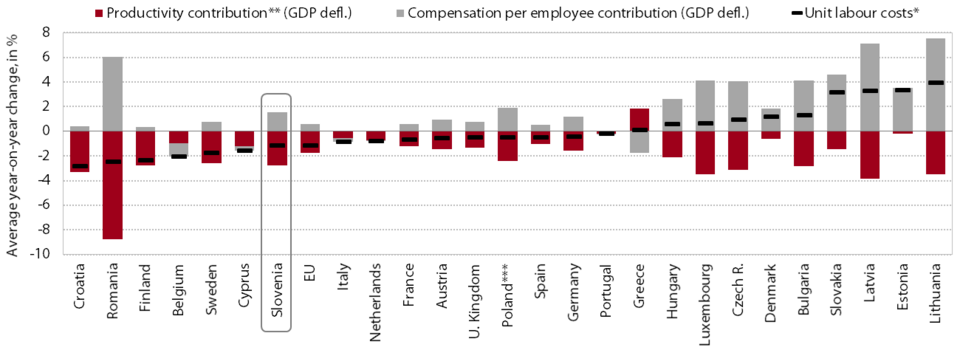
14. Exports of high-technology goods and knowledge-intensive services
The technological intensity of goods exports is rising. The share of high-technology products in total goods exports expanded particularly in the first years of the crisis, with the shares of other, less competitive, industries contracting more strongly. Over the last few years it has stabilised at around 20%, Slovenia thus exceeding the EU average. Particularly pharmaceutical exports increased in the first years of the crisis, but in 2013 their growth came to a halt due to the exchange rate movements and prices on some of the main markets (such as Russia). High-technology exports have otherwise expanded in absolute terms throughout the period analysed, particularly exports of electronic and telecommunication equipment and, in 2016, aircraft components. Exports of medium-technology products remain the highest, particularly of vehicles and machinery.
Despite the stronger export orientation of knowledge-intensive non-financial market services, their share in total exports of services remains among the lowest in the EU. Despite an increase in the share of knowledge-intensive services in total exports of services in recent years (to 23.1% in 2016), Slovenia’s gap with the EU average (37.7%) remained relatively wide in 2010–2016, at over 12 pps. Most sectors of knowledge-intensive services lagged behind the EU average, particularly computer services (around 7 pps). In the EU, exports of computer and information services rose the most during this period, affected primarily by strong growth in exports of computer services (around 20% per year on average) by Eastern European countries which joined the EU in 2004. In Slovenia, meanwhile, particularly telecommunication services achieved a higher share than in the EU, but in the three years to 2016, the share of these services in total exports of services declined both in Slovenia and in other EU Member States.
Figure: Share of knowledge-intensive non-financial market services in total exports of services, 2016
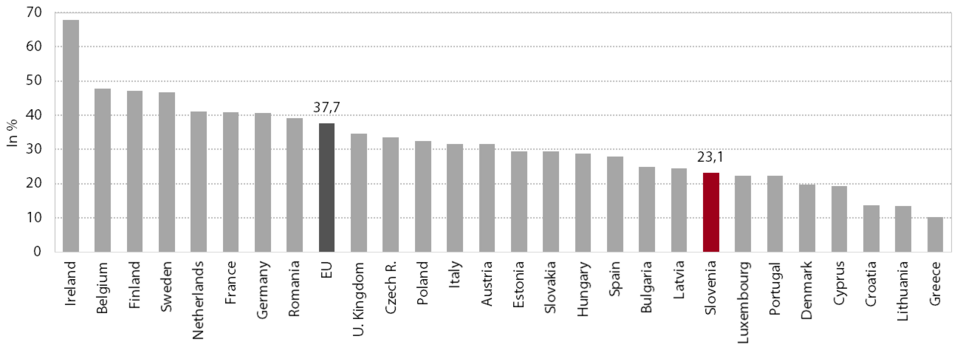
15. Foreign direct investment
Since 2014 inward FDI flows have been rising more rapidly (yet not faster than in most new EU Member States), while outward FDI remains modest. The increase in inward FDI is mainly due to accelerated privatisation and the generally higher sales of equity stakes in Slovenian companies. There have also been more expansions of existing foreign-owned companies in Slovenia. According to the results of the SPIRIT surveys for 2014–2017, each year of this period more than 35% of companies with foreign equity were planning to expand in Slovenia, a trend that may be expected to continue in the future, given than 38.2% of companies surveyed are also planning to increase their activities in 2018. On the other hand, outward FDI has been rising only modestly since 2014, following a decline in 2010–2013. In 2017 its stock was still 7.6 pps lower than its 2009 peak. The inflows and outflows of equity capital both dropped significantly in 2017.
Slovenia remains among the EU countries with the lowest inward FDI stock as a share of GDP. By 2017, the stock of inward FDI as a percentage of GDP had increased to 30.8%, which is around 8 pps more than at the beginning of the crisis. Slovenia thus ranks among the new EU Member States with the largest increases in the stock of inward FDI since the beginning of the crisis; at the same time, however, it remains among the EU countries with the smallest stock of FDI as a share of GDP. A smaller share than in Slovenia is recorded only by France, Germany, Italy and Greece. Slovenia’s outward FDI as a share of GDP dropped from the record 17.0% in 2009 to 13.5% in 2017. Among new EU Member States, Slovenia otherwise lags only behind Hungary and Estonia in this regard, but both these countries have significantly higher shares.
Figure: Stocks of inward and outward FDI, as a % of GDP
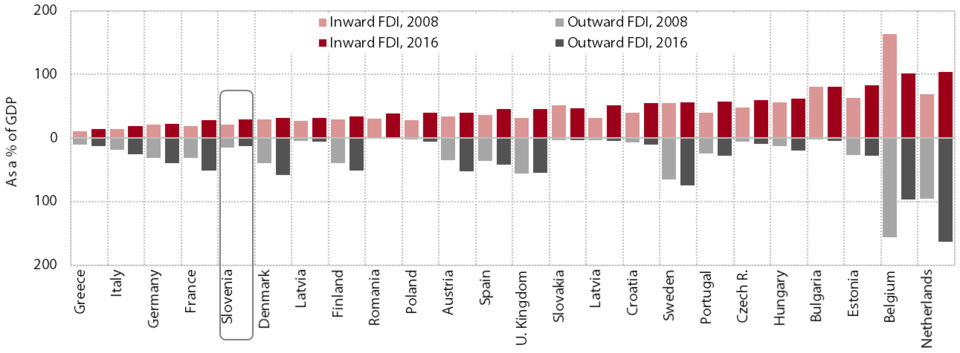
16. R&D expenditure and the number of researchers
R&D expenditure (as a percentage of GDP) had been rising until 2013, when it significantly exceeded the EU average. R&D expenditure first started to decline in the public sector, falling by 39.7% in real terms in 2012–2016. This indicates a significant divergence from the commitments of the Research and Innovation Strategy of Slovenia (RISS) for 2011–2020. Business sector expenditure had been the main driver of R&D expenditure growth up to 2015, when this expenditure also started to decline. An important factor in financing R&D investment of the business sector, in addition to own funds, was funds from the business sector abroad and the European Commission. The increase in the business sector’s expenditure on R&D was also boosted by considerable R&D tax relief. The share of business sector expenditure in total R&D expenditure is high in Slovenia. In 2016 it was 69.2%, considerably higher than the average in the EU (2015: 55.3%). Despite the strong economic growth in the last few years, R&D expenditure shrank in Slovenia, unlike in some more developed EU Member States where the share of R&D expenditure hovers around 3% of GDP or even higher (for example Sweden, Germany and Austria).
The number of researchers rose considerably in the last decade; most of them were employed in the business sector. Such movements are important for creating new knowledge, innovative products and services and enhancing the competitiveness of the economy. With the increase in business sector funding for R&D, the number of researchers almost doubled in the business sector in the last decade, to 4,500, in contrast to the public sector, where it rose only by around 50 (to approximately 3,600). The shortage of researchers in the latter will become particularly pronounced in the future, with the retirement of older researchers, and will be reflected in a lower level of breakthrough basic research, which is also the basis for business sector research. As in most other EU Member States, the bulk of researchers are employed in manufacturing. In services, which are characterised by lower R&D intensity, the overwhelming majority of researchers (over 90%) work in knowledge-intensive services.
Figure: The structure of researchers by sector of employment, 2016, as a % of all researchers
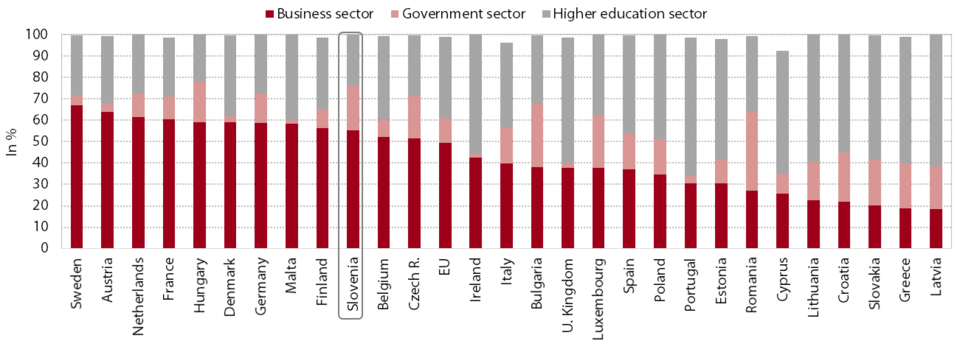
17. Innovation activity of enterprises
The innovation activity of enterprises did not increase between 2010 and 2014, meaning that Slovenia’s gap with the EU average widened further. In 2012–2014, 45.9% of enterprises were innovation-active in Slovenia, which is slightly less than in the previous three-year period (2010–2012) for which comparable data are available. In the EU, minimal progress was made, but the most innovation-active Member States increased their lead. The share of large innovation-active enterprises (IAEs) in Slovenia exceeds the EU average, while the share of small IAEs lags behind. Enterprises in manufacturing are traditionally more innovation-active than those in the service sector, but both lag behind those in the best performing countries by 10 to 20 pps, which is reducing their competitiveness. In those EU Member States where the share of IAEs decreased in the in 2012–2014 period, the gap between the manufacturing and service sectors, similarly to Slovenia, widened further. Among service activities in Slovenia, the share of IAEs is highest in computer services, at 72.5%; this is close to the EU average but significantly lower than in leading Member States (over 85%). The share of IAEs in all knowledge-intensive services together amounts to 55.6% in Slovenia. These services (e.g. ICT services and consultancy services) significantly contribute to the strengthening of innovation capacity in other sectors, thus improving the competitiveness of the entire economy.
The share of IAEs that introduced eco-innovations in 2012–2014 was one of the highest in the EU. It totalled over 60%, being higher only in Germany and Portugal. The greatest beneficiaries of eco-innovations were enterprises themselves rather than the end users of their products. This means that business interest is becoming an increasingly important incentive for introducing eco-innovations, unlike in the past, when eco-innovations were assumed to be beneficial mainly for the environment (Hojnik, 2016). As in leading EU Member States, eco-innovations mostly benefited enterprises by reducing energy consumption or CO2 emissions. The main motivations for introducing eco-innovations cited by Slovenian IAEs include (1) improved corporate image, (2) excessive energy, water or raw materials costs, and (3) environmental regulations, a list similar to that given by enterprises in leading countries of the EU.
Figure: Share of innovation-active enterprises in manufacturing and services in 2012–2014, as a % of all enterprises
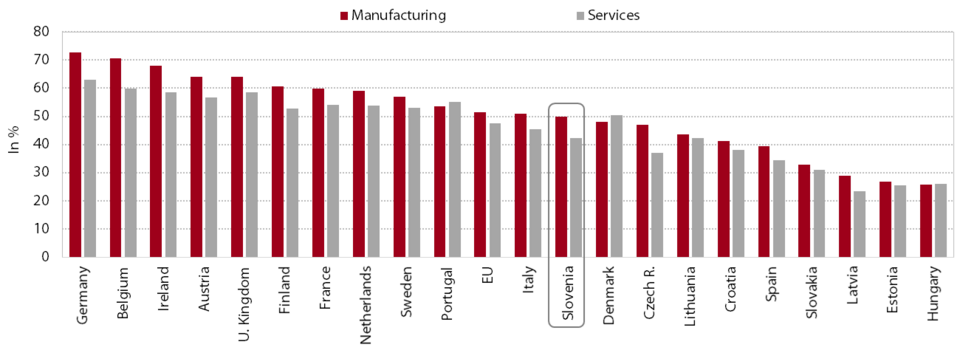
18. Intellectual property
Slovenia has made great progress in terms of EU trademarks and service marks since the beginning of the crisis but its gap with the EU average with regard to patents has widened. However, it remains the most successful country in Central Europe with regard to the level of patenting activity, which is measured by the number of first patent applications per million inhabitants. This can to some extent be explained by the relatively great importance of the pharmaceutical sector in the structure of Slovenia’s economy. Specifically, technologies in individual sectors are not equally patentable. According to the international WIPO methodology, the most patentable technological fields are medical technology, digital communications, computer technology, and technology related to electrical energy, machinery and apparatus. More than half of the patent applications filed with the EPO in 2010–2017 derived from these technological fields, and most of them were filed by large enterprises (EPO Annual Report 2017, 2018). In EU trademark legal protection, the number of Slovenia’s applications per million inhabitants has been rising faster than in the EU in recent years and Slovenia reached the EU average in 2017. In the number of Community designs per million inhabitants, Slovenia’s gap with the EU average remains wide, indicating insufficient use of the potential of creative industries to enhance the competitiveness of products and services. EU trademark and Community design protection, which can be obtained for the territory of the entire EU by filing a single application with the EU Intellectual Property Office (EUIPO), is becoming an increasingly attractive option owing partly to both the lower costs involved than in the case of patents and the much shorter registration procedure. These types of legal protection for intellectual property rights are therefore interesting for enterprises of all sectors, although they are particularly suitable for service activities and small and micro enterprises.
Figure: Number of EU trademark applications and registered Community designs with the EUIPO, per million inhabitants
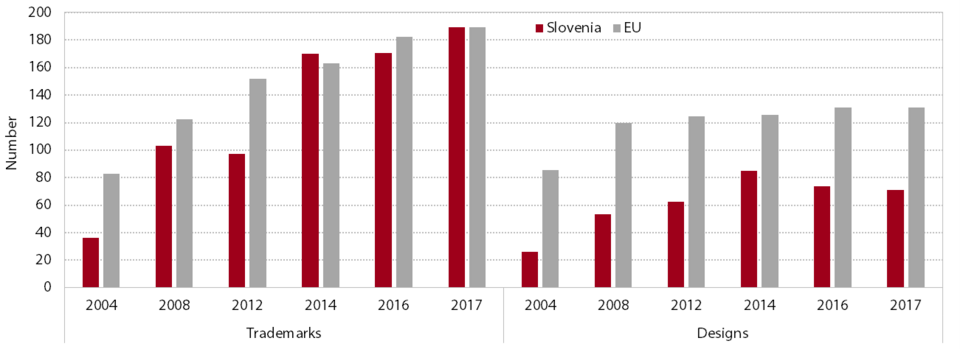
19. Corporate environmental responsibility
Corporate environmental responsibility refers to appropriate environmental management that organisations can demonstrate by obtaining various environmental certifications. Rising environmental awareness increases the need for companies and other organisations to demonstrate to various stakeholders that they effectively manage the impacts of their activity on the environment. They are therefore increasingly seeking environmental certification, for example the international ISO 14001 certificate, or joining the EU Eco-Management and Audit Scheme (EMAS). Environmental certificates under these two schemes are focused on impacts arising from an organisation’s activity, while for products or services with a reduced environmental impact, an ecolabel (such as the "EU Flower") can be obtained. Environmental certificates are important instruments in supporting sustainable production and consumption and sustainable industrial policy.
The number of environmental certificates per million inhabitants in Slovenia is similar to the EU average, the most widely used certificate being ISO 14001; the prevalence of the EU Ecolabel (EU Flower) is greater than in the EU as a whole. Until 2005 the number of ISO 14001 certificates per million inhabitants had been rising faster than the EU average; until 2011 it was higher than in the EU as a whole, then hovered around the EU average in subsequent years. Companies’ participation in EMAS and the number of EU Flower licences awarded are somewhat lower both in Slovenia and in the EU generally. In Slovenia, participation in EMAS increased only in 2015, whereby Slovenia moved into the upper half of EU Member States after previously recording the greatest gap on this indicator. Some EU Member States, in line with EC regulations, use measures facilitating organisations to register or remain registered with the scheme or offer incentives to registered organisations able to prove that they have improved their environmental performance. The EU Ecolabel (EU Flower) is more widespread in Slovenia than EMAS, the number of Ecolabel licences awarded exceeding the EU average. In addition to manufacturing (particularly the paper and chemical industries), the EU Flower is also widespread in tourist accommodation (in which sector the number of licence holders is also high in other Member States, for example France, Italy and Spain).
Figure: Number of environmental certificates (ISO 14001 and EMAS) in Slovenia and EU-28 Member States, 2010–2016 average

1. Share of the population with tertiary education
The share of adults (25–64 years) with tertiary education is rising and equals the EU average. Its growth is related to the long-term trend of high participation of young people in tertiary education. Such developments – which can be expected to continue in the future – are favourable, as a rise in the number of tertiary-educated persons tends to increase a country’s human capital and boost innovation activity. In view of the ageing population and the expected increase in business sector demand for workforce with tertiary education, it will be vital to ensure a sufficient number of tertiary-educated adults. The share of women with tertiary education is much higher than that of men, the gap between the two groups being wider than for the EU as a whole. In 2008–2016 the share of tertiary-educated people rose the most in the young (25–34 years) and middle (35–44 years) age groups, where it exceeds the EU average. Differences also exist at the level of statistical regions, the share of tertiary-educated adults being highest in Osrednjeslovenska (almost 40% in 2016) and lowest (half lower) in Zasavska. Since 2005 the share of tertiary-educated adults has been rising across all regions, while the disparities between regions have been declining.
The share of tertiary-educated young people (30–34 years) is high. Having already been rising for several years, it totalled 44.2% in 2016, which is higher than the EU average (39.1%) and higher than the Europe 2020 Strategy target (40%). It is much higher for women than for men. The problem remains the inefficient use of tertiary education, which is reflected in skills mismatch, as tertiary education is not sufficiently linked to the business sector’s needs. The efficiency of study is also low, the share of tertiary graduates in the 20–24 age group being low despite the high participation of young people in tertiary education. There is also room for improvement in the quality of tertiary education.
Figure: Share of the population aged 30–34 with tertiary education, 2016
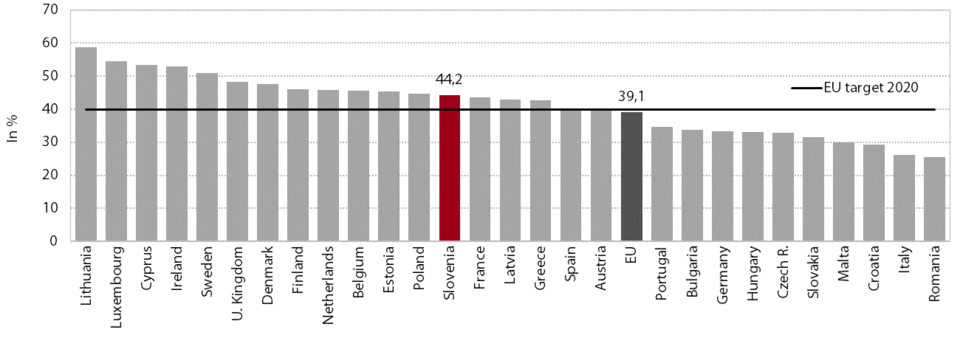
2. Participation in lifelong learning
The participation rate for adults (aged 25–64) in lifelong learning has been declining since 2011. In 2016, at 11.6%, it was higher than the EU average (10.8%), though lower than the objective of the strategic framework for European cooperation in education and training (Education and Training 2020/ET 2020), which is 15%, and the objective of the SDS 2030 (19%). Despite the end of the economic crisis and greater capability of companies and households to finance education, participation in lifelong learning has not yet started to increase, which reduces the possibilities of adults for successful inclusion in society. The low participation rates of low-educated people and older people with poor reading, mathematical and digital skills are particularly problematic. Among statistical regions, Osrednjeslovenska and Koroška had the highest and the lowest participation rates in lifelong learning in 2016 (14.5% and 8.5%) respectively, though since 2009 the gap between the two has mostly been narrowing.
The participation of working-age population (25–64 years) in lifelong learning has also remained unchanged. Since 2014 it has been hovering around 13%; this is higher than the EU average yet significantly lower than before the crisis. In 2016 participation in lifelong learning was highest in education and lowest in construction. It is on average higher in those sectors that have larger shares of people with tertiary education. It is also higher in the public than in the private sector. In 2008–2016 participation in lifelong learning declined in most activities (particularly in information and communication activities), which may reduce the possibilities for workers to adapt to global trends and for companies to increase their competitiveness.
Figure: Participation of employed persons aged 25–64 in lifelong learning, 2016
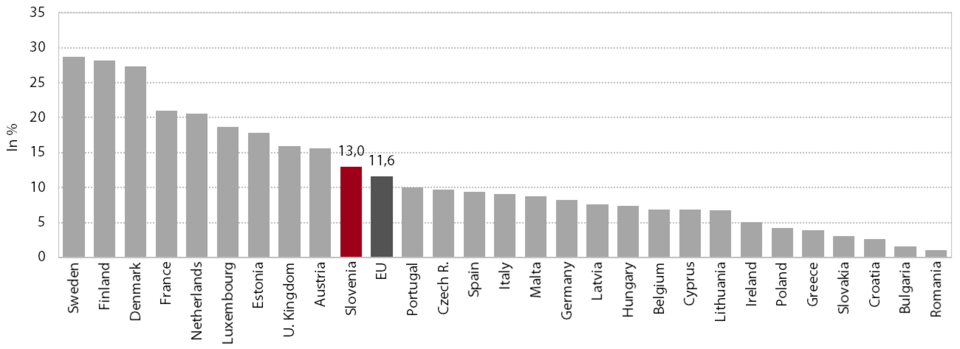
3. Performance in reading, mathematics and science (PISA)
The performance of Slovenian 15-year-olds in mathematics, science and reading literacy is good. According to PISA 2015, they scored higher than the EU average in all three literacy types and rank in the upper quarter of EU Member States. One of the 2020 benchmarks for the average performance in the EU set in the strategic framework for European cooperation in education and training (Education and Training/ET 2020) is that the share of 15-year-old pupils with low achievement (below proficiency level 2) in reading, mathematics and science should be less than 15% on the respective literacy scale. Slovenia has reached this goal in reading and science but is still below target in mathematics. While overall girls achieve better results in reading and science, boys score higher in mathematics. Between 2012 and 2015, Slovenian 15-year-olds improved their scores in mathematics and, in particular, reading, while their performance in science remained approximately the same.
The good results are related to educational (material and human) resources, an area where Slovenia has a favourable position on most indicators. Material resources include textbooks, library materials and laboratory equipment. As regards human resources, there is no shortage of teachers in Slovenia, Slovenia’s favourable position in this area being related to the number of certified teachers (i.e. teachers who have obtained a licence or passed a professional examination) and the pupil/teacher ratio. There is, however, still room for improvement in some indicators, such as class size, teachers’ help with homework, equipment of schools with computers and participation of teachers in professional development programmes.
15-year-olds from lower socio-economic backgrounds and those from immigrant backgrounds tend to achieve worse results in mathematics, science and reading. Pupils from the highest socio-economic backgrounds perform the best and those from the lowest the worst, but the gap between the two groups narrowed between 2012 and 2015 and was smaller than the EU average for all three literacy types. Immigrant pupils achieve worse results in science literacy than their non-immigrant peers, the difference between them being greater than on average in the EU.
Figure: Average performance in mathematics, science and reading of 15-year-olds (PISA), Slovenia and the EU, 2012 and 2015, in points
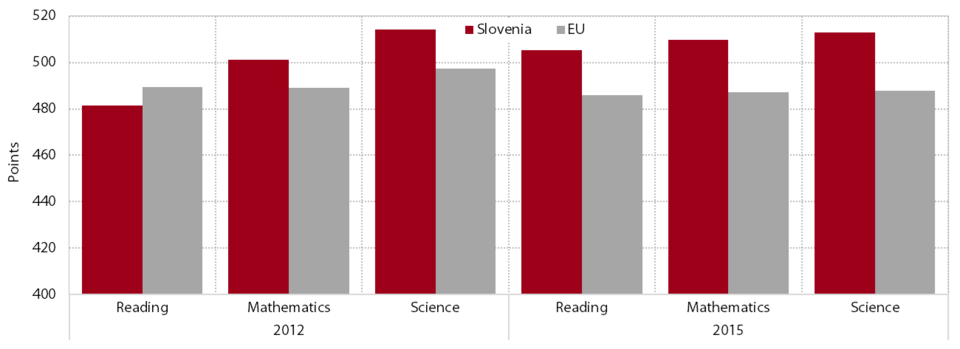
4. Enrolment in upper secondary and tertiary education
The number of young people enrolled in upper secondary education is falling, thus reducing the availability of future human capital. In the 2006/2007–2016/2017 period their number declined by approximately one-quarter for demographic reasons, which reduced the number of candidates for enrolment in tertiary education and entry to the labour market. Although those enrolled in vocational programmes represent a larger share in the structure of pupils in upper secondary education than on average in the EU, employers have difficulty finding appropriate workers, particularly those with vocational upper secondary education. A large share of young people (82.1%) are enrolled in educational programmes that enable direct enrolment in tertiary education, which – together with tuition-free full-time study at the first and second levels – makes it less likely that they will enter the labour market directly after completing the upper secondary level of education. The number of young people in vocational upper secondary education programmes declined, although their share increased. Until the 2016/2017 school year, there was no apprenticeship system in Slovenia (the type of training programme that strengthens the links between school and employers), unlike in the EU as a whole, where almost a quarter of all pupils enrolled in vocational education are engaged in apprenticeship programmes. In 2006/2007–2016/2017, enrolment in general educational programmes declined even more than that in vocational programmes.
Enrolment in tertiary education has also been falling for several years. The number of students in tertiary education has been declining since the 2010/2011 academic year. In 2009/2010–2016/2017 it dropped by almost a third, the most in social sciences, which also recorded a decline in their share. The shares of those enrolled in health and welfare and science and technology courses rose the most, though – owing to a falling number of students enrolled – not enough to meet the high business sector demand (see Indicator 2.5). Furthermore, the lower enrolment in health and welfare courses compared with the respective share of graduates is also problematic from the aspect of meeting the needs of an ageing society. Enrolment in tertiary education is still insufficiently matched with business sector needs. This is a consequence of there being no system for monitoring the employability of graduates and for long-term forecasting of labour market needs, which makes it difficult to plan enrolment based on business sector demand.
Figure: Structure of students enrolled in tertiary education by field of education, Slovenia and the EU, 2015
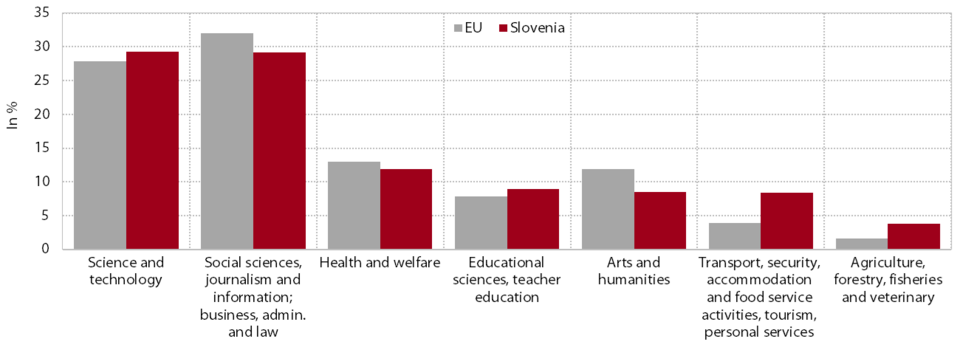
5. Graduates from tertiary education
The number of tertiary-level graduates is declining owing to demographic trends. It has been falling ever since 2013. Taking into account demographic projections and hence a decline in the number of students (see Indicator 2.4), similar trends are expected to continue in the future. The only exception was 2016, when the number of graduates increased significantly in all fields, this being the last year for completing studies under the pre-Bologna study programmes. In the structure of graduates, the share of graduates in social sciences dropped substantially in 2005–2016; given the falling enrolment rates, it is set to decline even more (Indicator 2.4). The share of science and technology graduates expanded the most, which is a consequence of increased promotion of enrolment in such courses. From the perspective of meeting the needs of an ageing society, the falling number of graduates in health and welfare poses a problem. These account for a much smaller share in the structure of graduates than on average in the EU. The possibilities for ensuring a sufficient number of persons with tertiary education are also restricted by the low efficiency of study. In the 2016/2017 academic year, the rate of transition into the second year of study was only 57.0%. The relationship between the number of graduates and the number of students enrolled (new entrants) would also improve with a higher efficiency of study. Slovenia has had 0.2 graduates per one new entrant in the last few years, except in 2016, the last year for completing the pre-Bologna study programmes, when the ratio rose to 0.4. The international exchange of students is also modest. The percentage of Slovenian students studying abroad (which should provide them with knowledge and skills that cannot be acquired at home) is lower than the EU-22 average. The share of students from abroad studying in Slovenia is also lower. With declining enrolment and the expected greater needs of the business sector and society, the problem of providing a sufficient number of graduates may worsen, especially in light of possible migration abroad, where the demand for this type of personnel is also high.
Figure: Structure of students enrolled in tertiary education by field of education, Slovenia and the EU, 2015, in %
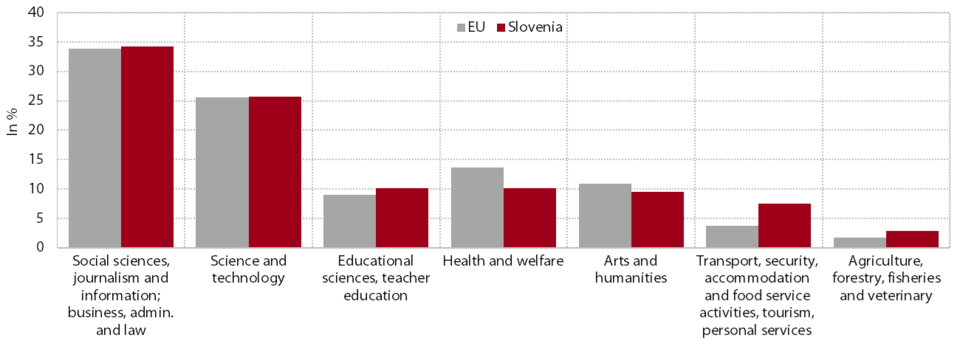
6. Education expenditure
Public expenditure on education (as a % of GDP) is below the EU average, while private expenditure is higher. Public expenditure has been falling since 2012. In 2016 it accounted for 4.51% of GDP and was the lowest in ten years. The decline since 2012 has been primarily a consequence of the Government’s fiscal consolidation measures, but also of certain other measures to rationalise the use of public expenditure on education. Public expenditure has dropped at all levels of education, but particularly pre-primary. In 2014 (the latest international data), expenditure on upper secondary and tertiary education was lower than the EU average, despite the higher participation of young people in education; expenditure on pre-primary and primary education was higher than in the EU as a whole. Private expenditure on education is also declining (in 2016 it amounted to 0.6% of GDP); according to data for 2014, however, it was still higher than the average for those EU Member States that are also OECD members (i.e. the EU-22).
Expenditure (both public and private) per participant in education is low, which can reduce the possibilities for improving the quality of education. In the last few years expenditure per participant has increased at all levels of education, particularly tertiary education, which saw a significant decline in the number of students enrolled. In 2014 (the latest international data), expenditure per participant was nevertheless lower than the EU-22 average, except for that on pre-primary and primary education, which is higher than in the EU as a whole – at the pre-primary level owing to the favourable pupil/teacher ratio and at the primary level due to the extended primary school programme. At the upper secondary and tertiary levels it is significantly below the EU-22 average owing to the high number of participants. At the tertiary level, it is also low because full-time students enrolled in 1st and 2nd study levels pay no tuition fees, which makes international comparisons questionable.
Figure: Expenditure on educational institutions per participant, in PPS USD, 2014
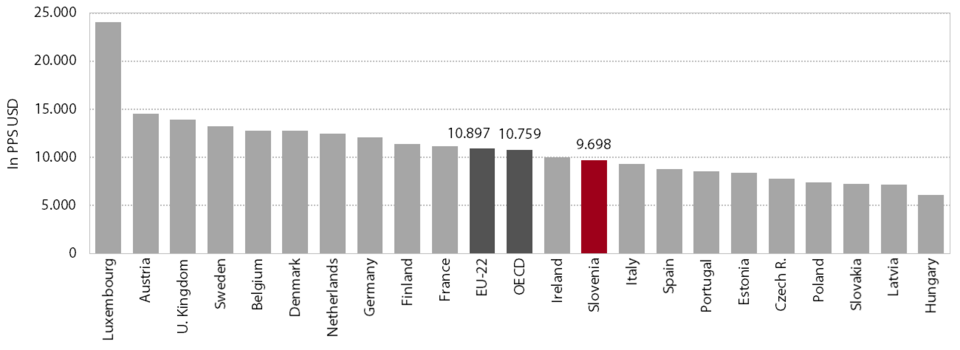
7. Attending cultural events
The average attendance at cultural events per inhabitant rose in 2008–2016. It was highest in 2012, owing to the many events hosted by Maribor, the city that held the European Capital of Culture title that year. In the remaining years of this period it amounted to around 5–6 visits per inhabitant, which is far below the SDS 2030 target. The number of people attending cultural events rose in 2008–2016, reaching 12.3 million in 2016. The highest attendance in 2016 was reported for cultural events carried out by cultural associations. Attendance at such events rose significantly during the 2008–2016 period, owing not only to higher numbers of cultural associations and members thereof, but also to a greater supply of events. In 2016 significant attendance was also recorded by houses of culture and cultural centres. At the same time, cinema attendance dropped in the 2008–2016 period owing to fewer people going to see foreign feature films, while attendance at screenings of Slovenian films increased.
Figure: Attendance at cultural events, Slovenia, 2016
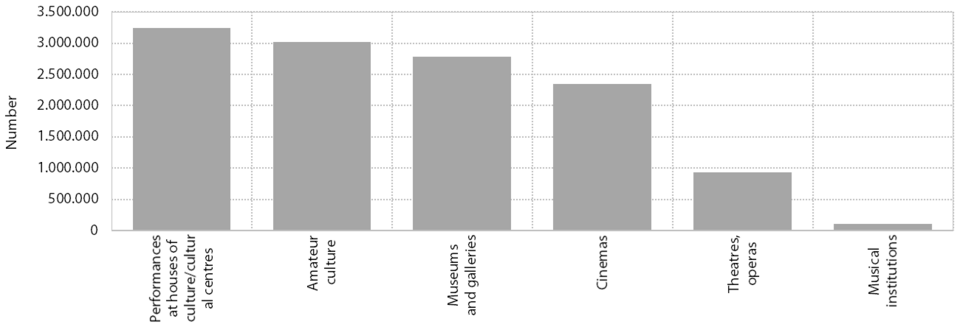
8. Share of cultural performances held abroad
The share of cultural performances held abroad totalled 2.7% in 2016. Touring is an indirect indicator of the quality of cultural production, given that invitations to perform abroad are assumed to represent recognition of a cultural institution’s good work. Because of the short data series, developments in this area are difficult to assess: data are only available for 2016, while the figure for 2015 is SURS's estimate (see note to table below). According to these data, the share of cultural performances abroad remained more or less unchanged in 2016 compared with the previous year and is still far below the SDS target for 2030. Among performances held abroad, those in the EU accounted for the largest share (around 90%), which reflects the geographical attachment of Slovenian culture to this area. In 2016 musical institutions had the most performances abroad, which we assess is related both to the nature of their work and to systematic promotion of international cooperation.
Figure: Share of cultural performances on tours abroad, Slovenia, 2016
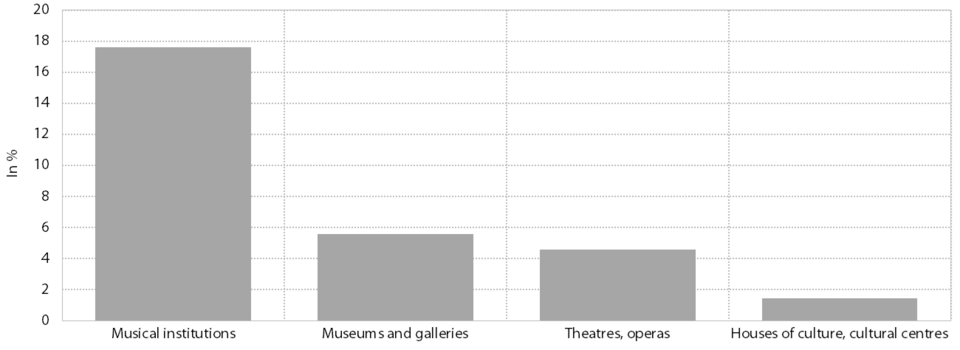
(copy 3)
1. Social exclusion rate
After peaking in 2014, the rate of social exclusion dropped to 18.4% in 2016 and was, as in the last ten years, lower than the EU average. After rising in 2007–2014, the values of individual components of this composite indicator decreased in Slovenia in 2015 and 2016, though they remained higher than before the crisis. With the improvement in labour market conditions after 2013, the proportion of persons living in households with very low work intensity declined; in 2016 it totalled 7.4%, which is slightly more than in 2007. Despite the fall in the last nine years, the severe material deprivation rate and the at-risk-of-poverty rate remained higher than before the crisis. The at-risk-of-poverty threshold for a single household in the last two years remained approximately the same (EUR 616). In 2016, a total of 280,000 persons lived below the poverty threshold, 7,000 fewer than in 2015 and 39,000 more than in 2008. Both the at-risk-of-poverty rate and the proportion of persons in households with very low work intensity were still higher than in the pre-crisis year 2008.
With the improvement in economic conditions, the risk of social exclusion declined for most population groups. Throughout the period analysed, the at-risk-of-poverty rate was the highest for the unemployed (44.7% in 2016, down 0.1 pps year on year). Broken down by age, people over 65 are still at the greatest risk, though this is at the same time the only age group where in 2016 the at-risk-of-poverty rate was lower than before the crisis. Among those under 65 years old, the risk of poverty is highest in the 50–65 age group, where it has been rising since 2013 (from 13.2% in 2012 to 15.4% in 2016, when it peaked). This can be attributed to the high share of long-term unemployed in this age group and the low employment rate, one of the lowest in the EU. In 2016 the at-risk-of-poverty rate rose the most for retired persons under 65 (by 2.8 pps relative to the preceding year to 16.4%) The at-risk-of-poverty rate for people aged less than 18 declined by 2.3 pps and for single-parent families, also one of the most vulnerable population groups, by 7.2 pps (to 25.3%). This is considered to be a result of the new Scholarship Act from 2013 and the reinstatement of government scholarships for underage pupils.
Figure: The at-the-risk-of-social exclusion rate, 2008 and 2016

2. Inequality of income distribution
The low income inequality in Slovenia is to a great extent the result of redistribution policy. Slovenia is a country with strong income redistribution through high progressivity of taxation (personal income tax) and moderate redistribution of income through social transfers. In 2000–2012 the levels of income redistribution changed only marginally. Major changes did occur after 2012, however, with the adoption of austerity measures and social policy changes. The adopted measures reduced social transfers, which had been raised considerably during the crisis. At the same time, they changed the redistribution of income from employment by progressively reducing the earnings of public sector employees. The economic crisis was not reflected in higher income inequality in 2009–2012 precisely thanks to social transfers, which mitigated the effects of the crisis either as automatic stabilisers or as special measures adopted to protect the material standard of the poorest population groups. Income inequalities did not change in Slovenia with the revival of economic activity and a gradual removal of austerity measures.
Income inequalities in Slovenia are low; in 2016 they were among the lowest in the EU. In 2016 they were slightly higher than in 2008, similarly to the EU as a whole, where the largest increase was recorded for Bulgaria. As in other countries, the share of income of the 1% of equivalent household members with the highest incomes is rising at a rapid pace (from 3.3% in 2005 to 3.7% in 2016). Though it is still lower than the EU average (5.0%), its growth is now one of the fastest among EU Member States.
Figure: Inequalities of equivalised disposable income distribution, quintile share ratio (S80/S20)

3. Experience of discrimination
The share of people who experienced discrimination in Slovenia in 2015 was among the lowest in the EU and lower than in 2008. Overall 13% of respondents experienced discrimination in 2015, which is significantly below the EU average of 21%. The most frequently mentioned reasons for discrimination were being over 55 years old and gender (3%), followed by being under 30 years old, religion or beliefs, and disability (2%). Discrimination based on ethnic origin, sexual orientation or gender identity was experienced by 1% of respondents, while 5% of respondents experienced being discriminated against for other reasons. All these shares are lower than the EU average, except the shares of those feeling discriminated against for being younger than 30 years or because of their gender identity, which equal it. According to the European Social Survey data, the share of respondents who have a few good friends of a different ethnic origin than their own and the share of those who think that it is a good thing for people to interact with people of different ethnicity are larger than in the EU as a whole. The latter is likely the reason for the relatively low share of people who felt discriminated against for their nationality, where Slovenia differs the most from the EU average. The awareness of rights in the event of discrimination is also relatively good in Slovenia, as two-thirds of respondents said they would know their rights should they fall victim to discrimination or harassment. More than half of respondents think that the media sufficiently reflects diversity with regards to various groups, although the perceived diversity in the media varies depending on the group in question. Most respondents agree that school lessons and materials should include information about diversity in terms of ethnic origin (71%), religion or beliefs (71%), sexual orientation (63%), and gender identity (61%).
Figure: Experience of discrimination, 2015

4. Median equivalised disposable income
The gradual real growth of median equivalised disposable income was interrupted by the economic crisis, social policy changes and austerity measures; amid a rebound in economic activity, it records modest growth. In 2016 the median income expressed in euros exceeded the 2006 level in real terms. Slovenia ranks in the middle of EU Member States on this indicator, together with Spain, Italy and Cyprus, which all have higher GDP per capita than Slovenia. The period of 2005–2016 was characterised by very rapid growth in median incomes in Eastern European countries and significantly lower growth in the countries that were most affected by the crisis (including Slovenia), while in Greece median income even declined.
The decline of income in lower income brackets mainly reflected loss of employment, while income of people with higher education dropped primarily as a result of austerity measures in the area of public sector earnings. In 2008–2016 the share of income from employment in equivalised disposable income declined, by far the most for the first two income quintiles. This was attributable to the fall in employment of low-skilled workers particularly in labour-intensive sectors which contracted strongly during the crisis. In 2009–2012 the loss of earnings of low-skilled workers (due to unemployment or a drop in income from employment) was cushioned by social transfers, but after 2012 these transfers decreased owing to austerity measures and social policy changes. Since 2014 income from employment has risen slightly, boosted by stronger economic activity and hiring, but only for households in the second quintile. In 2013–2014 the level of income from employment was also significantly affected by the progressive reduction of public servants’ wages, a measure which lowered income from employment for tertiary-educated employees and had not yet been fully abolished by the end of 2016 even with the revival of economic activity. Median incomes by educational attainment in Slovenia have consequently moved even further from the EU average.
Figure: Median equivalised disposable income, in PPS

5. Life satisfaction
After falling during the crisis, life satisfaction has been rising in Slovenia since 2013, reaching its highest level in 2017 (92%). The share of people satisfied with their lives has exceeded the EU average ever since 2004, when Slovenia was first included in Eurobarometer measurements. In 2017 Slovenia was also one of the six countries recording a continuous increase in the share of satisfied respondents in the last three measurements (together with Luxembourg, Hungary, the Czech Republic, Cyprus and Portugal).
In 2017 the already high shares of people satisfied with their own financial and employment situation (73% and 62% respectively) reached and exceeded their pre-crisis levels. Satisfaction with one’s personal employment situation is the only area measured where satisfaction did not increase from the previous measurement. The shares of respondents satisfied with the employment situation in the country (25%) and the economy at the country level (46%) have also been rising without interruption since autumn 2014, though these have yet to reach their pre-crisis levels. When asked to identify two main issues at the personal level, in 2017 Slovenian respondents pointed to pensions, social and health security, living conditions, the cost of living, and working conditions.
At the country level, social and health security was stressed as the main concern (38%). Other frequently mentioned issues were unemployment (29%), the economic situation of the country (24%), pensions (19%) and public debt (15%). The issue of social and health security has been coming to the fore since autumn 2012, while concerns about unemployment, though still frequently mentioned, decreased to their lowest level since the beginning of the crisis and by 32 pps from their highest level in spring 2014. The frequency of citing the economic situation of the country is 43 pps lower than its peak in autumn 2011, while concerns about pensions and public debt remained at almost the same level in the last two years. Expectations for the next 12 months are moderate, the greatest improvements being expected in the employment situation at both the personal and country levels (both by 3 pps).
Figure: Life satisfaction, in %

6. Social protection expenditure
In 2015 Slovenia allocated more funds for social protection than in 2008, primarily owing to population ageing and mitigation of the effects of the economic crisis, yet still less than the EU average. As a share of GDP, social protection expenditure totalled 23.7% in 2015, up 2.7 pps on 2008, when it bottomed out, but the share remained below the EU average throughout the period (at around 29%). During the crisis the growth of social protection expenditure arose mainly from higher expenditure on old age, which makes up the largest share of total social protection expenditure owing to the rising number of pensioners. Given the increase in the number of the unemployed during the crisis, expenditure on unemployment benefits also rose considerably, though its contribution to the growth declined slightly with the improvement in labour market conditions in 2014 and 2015. Expenditure on social exclusion not elsewhere classified was also higher; following a period of decline, this had started to rise rapidly with the onset of the crisis. The significantly higher expenditure on sickness and healthcare than before the crisis is mainly the result of higher expenditure on sickness benefits.
Slovenia lags behind the EU average in terms of social protection as a share of GDP, most notably in expenditure on housing and unemployment benefits, but it allocates more than the EU average for social exclusion benefits not elsewhere classified. The system nevertheless provides relatively good access to health services and reduces the poverty risk. Slovenia has the widest gap with the EU average in expenditure on unemployment benefits. The duration of benefits being similar to the EU average, this is primarily a consequence of the small share of unemployment benefit beneficiaries among the unemployed compared with other Member States. Slovenia is also one of the countries with a relatively high replacement rate at the early stage of unemployment, one of the highest in the EU. The relatively low expenditure on housing is to a great extent related to the only modest level of rental housing market development and the small share of non-profit housing in Slovenia.
Figure: Social protection expenditure in PPS per capita, 2015

7. Housing deprivation rate
Slovenia is one of the countries with the highest housing deprivation rates in the EU. In 2016 almost one-quarter of Slovenia’s population suffered from housing problems of one kind or another. The regions with the highest shares (over 30%) of the population living in poor housing conditions are Pomurska, Zasavska and Goriška. The corresponding share in the EU as a whole is around 15%. Only Portugal, Cyprus and Hungary have higher rates of housing deprivation than Slovenia. The rate for the EU as a whole has been stable since 2011, while the rate for Slovenia has been gradually declining. In 2011 more than one-third of the population suffered from some type of housing problem, one of the reasons being the relatively old housing stock, given that as many as 83% of flats had been built before 1990. Since then, the construction of new flats has been modest, which is a consequence of housing policy.
In 2016, 4.5% of the population faced severe housing deprivation in Slovenia. The rate of severe housing deprivation is significantly lower than the rate of housing deprivation and even somewhat lower than the EU average. Having been steadily declining since 2011, the severe housing deprivation rate first fell below the EU average in 2016. The overcrowding rate also fell, this by almost 4.5 pps (in the EU by 0.4 pps). The improvement in the housing stock since 2014 reflects the positive effect of loans and non-repayable subsidies (grants) for environmental investments offered by the Eco Fund.
Figure: Housing deprivation rate and severe housing deprivation rate, 2016

8. Housing cost overburden rate
With the improvement in the financial situation of households, the housing cost overburden rate dropped in the last two years of the period analysed. With the decline in disposable income and accelerated growth in housing costs, the housing cost overburden rate increased in Slovenia in 2008–2013, rising faster than in the EU as a whole. By 2016 it had declined to 5.7% and was 1.3 pps higher than in 2008. In 2016 housing costs represented a heavy burden for 32% of Slovenian households, this despite the improvement in their financial situation, i.e. an increase in disposable income and a fall in the overburden rate. Owing to financial distress, 15% of households were in arrears with their payments of housing bills at least once; among these, the majority (85%) were unable to pay their bills on time twice or more. Housing costs were an excessive burden particularly for households below the poverty threshold. In 2016 the overburden rate in the first quintile remained higher than in 2008.
The share of the population overburdened with housing costs in Slovenia is almost half lower than in the EU as a whole (11.1%), which is explained by the ownership structure. Slovenia ranks among the quarter of countries with the lowest housing cost overburden rates. The relatively low rate in Slovenia is due to the structure and ownership of dwellings. In the EU 60% of people on average live in houses and 40% in flats, more than two-thirds of which are owner-occupied. The Slovenian averages are 70% and 30% respectively, around 76% of all properties being owner-occupied. In the EU, on the other hand, more than one-quarter of people living in an owner-occupied home had a mortgage or an outstanding loan in 2016. In Slovenia, this share was around 10%.
Figure: Housing cost overburden rate, 2016
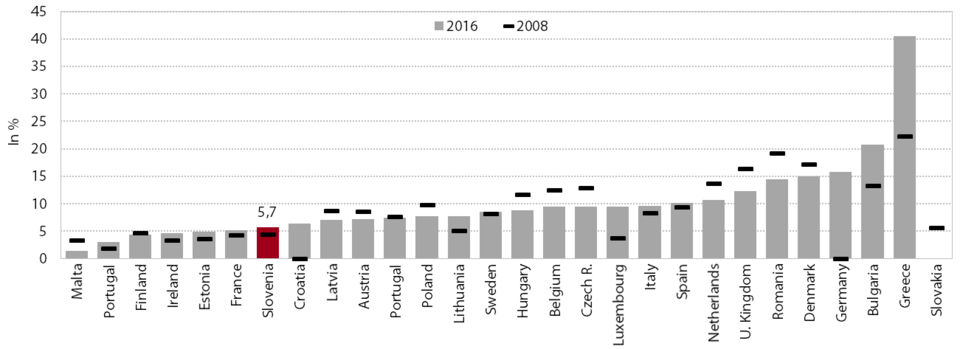
9. Material deprivation rate
After rising during the crisis, the material deprivation rate fell sharply in 2015 and 2016, reaching its lowest level to date in both Slovenia and the EU. In 2016 it totalled 13.5% and was, as in previous ten years, lower than the EU average. In 2016, there were 273,000 materially deprived people in Slovenia, 72,000 fewer than in 2011 and 2014, when their numbers were the highest. The material deprivation rate among people below the poverty threshold was also lower than in previous years (38.4%), yet significantly higher than among those above the poverty threshold (13.5%), the gap between the two groups being even wider than before the crisis. The lowest (and lower than the Slovenian average) material deprivation rates are recorded for children, followed by people over 65 years old, and the highest for working-age people (18–64 years).
A large majority of the population was able to afford basic durable goods in 2016. Highest were the shares of people able to afford items such as a telephone (99%), a washing machine (98%), a colour TV (97%), sufficient fuel to keep their home adequately warm (95%), a car (84%), a personal computer (77%), or a meal with meat or a vegetarian equivalent (93%). All these shares were the highest since first measured. A similarly high share of people was also able to afford a one-week holiday away from home (69%). The share of people able to deal with unexpected expenses (55%) rose as well, having been higher only in 2007 and 2009.
The ability of households to make ends meet in 2016 was the highest in the entire period analysed. The share of those who make ends meet easily or fairly easily was higher than in 2016 (35%) only in 2007. The corresponding share of those who have some difficulty in making ends meet had already been close to its lowest level for two consecutive years (37.2%). The share of those who have difficulty or great difficulty was also the lowest (25.9%) in seven years, though still higher than in 2007. Among households that had been able to make ends meet with (great) difficulty in 2007, the financial situation improved only for those with two adults and three or more dependent children, which represented the lowest share of households with (great) financial problems in 2016; the second lowest share was that of households with at least one adult over 65 years old. The greatest deterioration was recorded for single women (42.2%), followed by one person younger than 65 years (37.6%) and two persons younger than 65 years (27.9%), which can be attributed to the problem of the working poor or even to age discrimination. As in all previous years, single mothers struggle the most to make ends meet.
Figure: Material deprivation rate
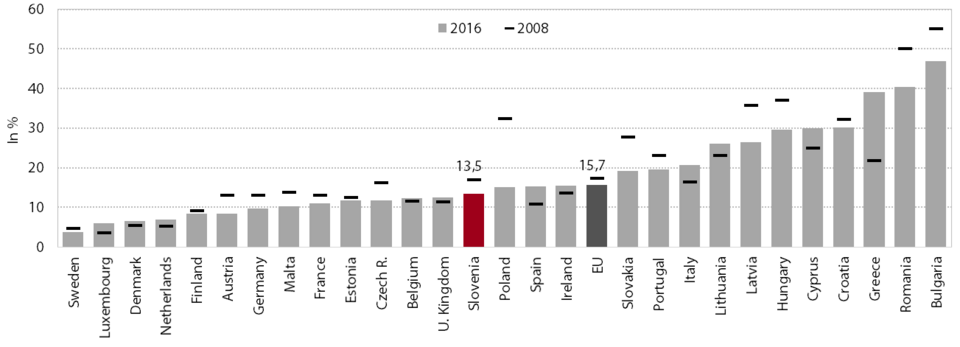
10. Employment rate
The employment rate (among 20–64-year-olds) has been rising since 2014; in 2017 it exceeded the EU average again after dropping below it during the crisis. In the second quarter of 2017 it reached the pre-crisis level from 2008. In addition to favourable economic conditions, its growth is more and more affected by demographic trends. Since 2014 the employment rate has been rising particularly among young people (20–29 years), which were strongly hit by the crisis owing to their high exposure to fixed-term employment contracts (which were not being extended during the crisis) and a decline in student work. The favourable developments since 2014 reflect increased hiring, a larger volume of student work, demographic trends and active employment policy programmes targeted at young people. The employment rate for older people (55–64 years) continued to rise during the crisis, partly as a result of the pension reform and demographic effects. Despite the increase, it remained among the lowest in the EU in 2017.
Since the crisis, the employment rate has been rising in all education groups, the most among low-skilled people and those with secondary or upper secondary education. It was people with low, secondary or upper secondary education who were affected the most by the crisis (also in comparison with the EU average), this owing to a significant decline of activity in construction and manufacturing. The improvement in the last few years reflects the structure of the recovery of economic activity and strong hiring in sectors where such workforce predominates (manufacturing, transportation, accommodation and food service activities, and employment activities, which mostly provide workers to the manufacturing sector). The employment rate for those with higher education fell the least during the crisis, as in other EU countries, mainly due to a smaller contraction of activity in sectors that employ better educated workforce and hiring in public service activities. The employment rate for those with higher education is gradually rising and remains somewhat higher than the EU average.
Since 2013 the employment rate has been rising across all regions, the fastest in Vzhodna Slovenija Among the regions of Vzhodna Slovenija – which is below the EU average – Zasavska has the lowest employment rate (64.9% in 2016), but this region is narrowing the gaps with the EU and Slovenian averages at the fastest pace. The employment rate in Zahodna Slovenija exceeds the EU average by 0.9 pps.
Figure: Employment rate, in %
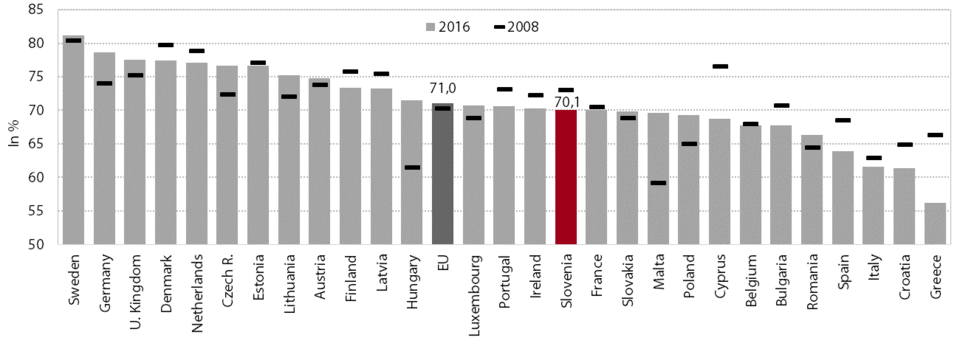
11. At-risk-of-poverty rate of employed persons
After rising during the crisis, the at-risk-of-poverty rate of employed persons dropped to 6.1% in the last three years of the period analysed and is below the EU average. In 2013–2016 it fell by 1 pp, in line with what is required for Slovenia to meet the SDS target (below 5%). In terms of the at-risk-of-poverty rate of the employed aged 18 years or more, Slovenia has performed better than the EU average since measurements began.
Throughout this period, the at-risk-of-poverty rates of the employed were the highest among those in atypical forms of employment. In 2016 the at-risk-of-poverty rate for people with permanent employment contracts totalled 3.4%, similar to its pre-crisis level. For those with fixed-term employment contracts, it fell in the last two years, from 14.6% to 9.3% in 2016. Meanwhile, the at-risk-of-poverty rate for people working shorter hours rose again, from 13% to 15.6% in 2016, the highest level thus far. The at-risk-of-poverty rate for the self-employed in 2016 was 23%, down 4.8 pps from its 2014 peak. An individual’s decision on whether or not to accept work or an atypical form of employment is, in our estimation, determined on the one hand by the fact that the at-risk-of-poverty rates of unemployed, retired or other inactive persons are significantly higher than those of persons in employment (any form of employment) and, on the other, relatively low work incentives.
Figure: At-risk-of-poverty rate of employed persons aged 18 years or more
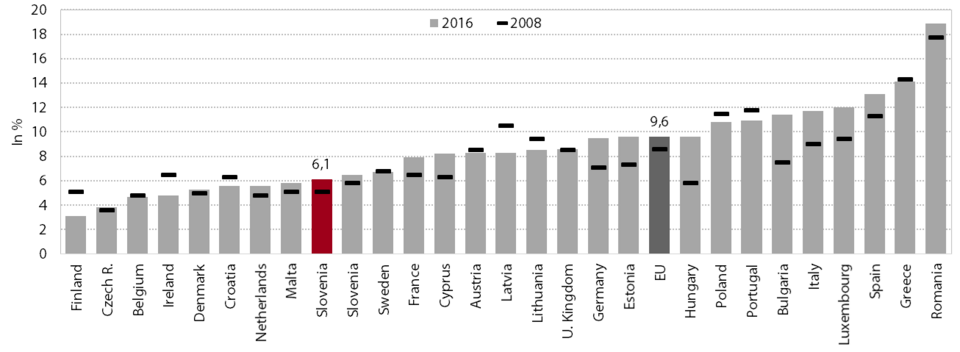
12. Unemployment and long-term unemployment
After rising sharply in 2008–2013, the unemployment rate has been rapidly declining since and remains lower than the EU average. By the second quarter of 2017 it had dropped to 6.4%; its decline, faster than on average in the EU, is related to vigorous economic growth and stronger employment. In the crisis years the unemployment rate rose more for men (and exceeded the rate of women), as those sectors where male workforce predominates were strongly affected by the crisis. In the last years of the period analysed, the male unemployment rate otherwise remained lower than the female rate owing to the structure of the recovery of employment in labour-intensive sectors and restrictions on hiring in public service activities, where women make up a larger share of the workforce than men. For similar reasons unemployment declined the most among people with low, secondary or upper secondary education. The unemployment rate of young people (15–24 years), who were hit hardest by the crisis, dropped by more than half from its 2013 peak, to 10.0% in 2017, and was significantly below the EU average of 16.9%.
Dropping for the third year in a row, the long-term unemployment rate fell to the EU average in 2017. As a result of weak labour demand, the long-term unemployment rate rose sharply in 2009–2014. At the beginning of the economic rebound, the situation first only improved for those unemployed for shorter periods of time, but in the following years the number of long-term unemployed also started to fall thanks to strong hiring and active employment policies. During the crisis the long-term unemployment rate of young people rose the most. It has since also fallen the most in subsequent years. Despite a notable decline in long-term unemployment, every second unemployed person remains unemployed for more than one year.
Figure: Unemployment rate, annual average, in %
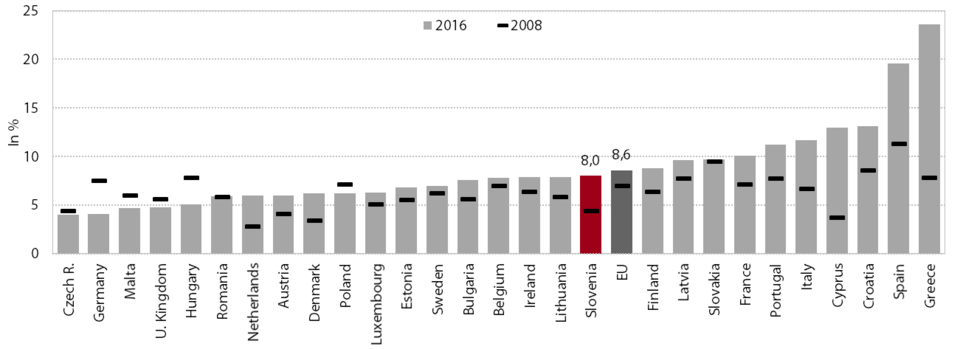
13. Young people not in employment, education or training
The share of young people neither in employment nor in education or training (the NEET rate) is below the EU average. Although it was increasing faster than in the EU as a whole in 2008–2016, it remained below the EU average throughout the period owing to the high participation of young people in upper secondary and higher education. In the last two years it fell due to the recovery of the labour market and lower labour supply owing to demographic change (i.e. smaller generations of young people). In 2016 the NEET rate was highest for those aged 25–29 (Slovenia: 15.7%; EU: 18.8%), which is when many young people complete their studies. Young people are facing difficulties when transitioning from education into employment, which reflect the skills mismatch and a lack of jobs for graduates. In the last year the NEET rate dropped particularly for the age groups 20–24 and 25–29, which might be attributed to government measures taken to promote youth employment, given that the NEET rate for those aged 30–34, i.e. the group that is not reached by these measures, remained approximately the same. A further decline in the NEET rate could be achieved by stepping up measures strengthening the links between upper secondary and tertiary education and enterprises amid the anticipated further recovery of the labour market. Women tend to face more problems in transitioning from education into employment than men and the NEET rate (20–34 years) among women is higher than among men. In 2016 the gender gap was wider than at the beginning of the crisis.
Figure: Share of young people (25–29) neither in employment nor in education or training
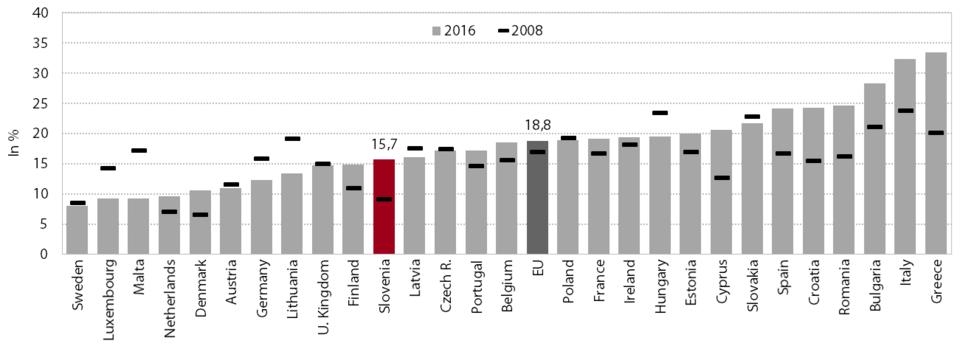
14. Precarious and temporary employment
The share of precarious employment, one of the indicators of the quality of employment, rose slightly in Slovenia in 2008–2016 and was significantly above the EU average. In 2016 the share of precarious jobs among women aged 20–64 totalled 4.6% (EU: 2.1%) and among men 3.8% (EU: 2.2%). As in other Member States, precarious jobs are most prevalent among young people, women and low-skilled workers. The European Commission finds that in Slovenia older non-standard workers are at much higher risk of labour market precariousness than younger people (25–39 years), which might be attributed to the better educational structure of younger age groups and to the poorer opportunities of older people for transition into employment and their higher share in low-paid jobs. Besides by the relatively high share of precarious jobs, the relatively low quality of employment in Slovenia is also indicated by the indicator of the share of low-quality jobs according to the Eurofound survey.
The share of temporary employment also rose slightly in 2008–2016 and is above the EU average. Slovenia is one of the countries with the largest shares of temporary jobs, which indicates job uncertainty for a significant share of employed persons and employers’ caution in hiring for an indefinite period of time due to employment protection. This is also reflected in the frequent hiring of workers through employment agencies, which in Slovenia also include agencies specialised for student work. In 2016 the share of temporary employment in the 20–64 age group was 16.4%, which is 0.5 pps more than ten years before. As in precarious employment, the share is higher for women and young people. The share of temporary jobs in the 15–24 age group is the highest among EU Member States, to a great extent owing to the prevalence of student work. In terms of temporary employment, Slovenia exceeds the EU average in all age groups except for those aged 55–64 years.
Figure: Share of precarious employment, in %
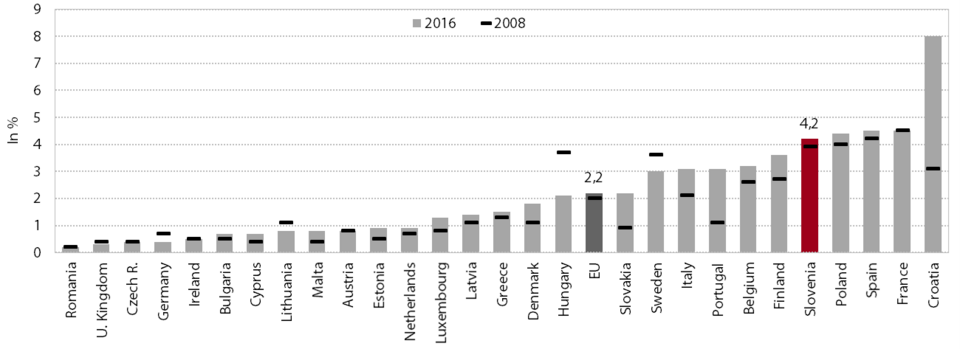
15. Absence from work due to illness
After declining during the crisis, absenteeism has again started to rise in Slovenia in recent years. In the period of the crisis, absence from work declined, which can be attributed mainly to the decline in employment and to a higher risk of losing employment. In 2015–2017 it was again rapidly rising. As the main reasons we can cite growth in employment, later retirement, prolongation of waiting times and increased participation in kindergartens. Absenteeism is significantly higher among women than men and the gap is widening every year. In 2016 persons employed were on average absent from work for 14.5 calendar days, the share of sick leave from work averaging 4.0% (NIJZ, 2018).
In terms of working days lost Slovenia exceeds the EU average. After several years of decline during the crisis, the number of working days lost per worker due to sick leave as reported to international databases (excluding the first day of absence and absence to care for a family member) rose in 2015 and again in 2016. The international comparability of this indicator is however limited because of methodological differences in data capturing and the differences in the health and social care systems and eligibility criteria for sickness benefits.
A further increase in absenteeism is also evident from data for 2017, according to which the number of working days lost increased strongly for the third consecutive year. The number of sick leave cases was up 25% in the last three years of the period analysed, compared to 2008 by more than 35%. In 2017 the number of working days lost increased to 11,396,629 (of which 2/3 were at the employer’s expense and 1/3 at the expense of the HIIS). The share of absences chargeable to the HIIS has been rising ever since 2009. According to HIIS data, the number of long-term absences in particular has surged in recent years, which can be explained partly by the ageing of the active population and changes to pension legislation but also to the unlimited duration of receiving statutory sickness benefits.
Figure: Number of working days lost per worker, 2015 (or latest available year)
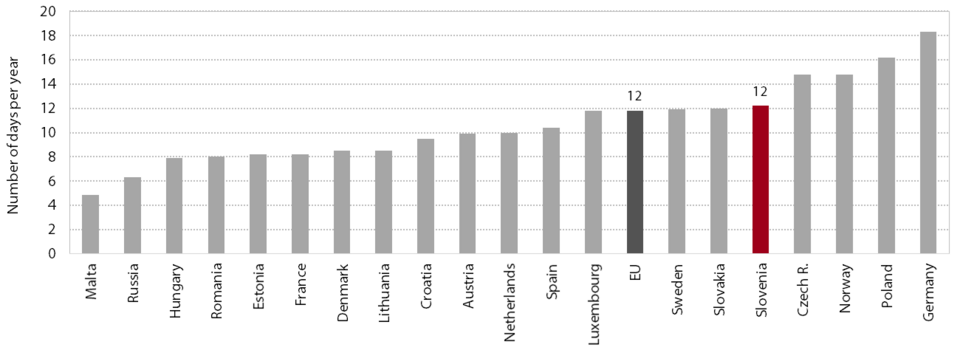
16. Accidents at work and other work-related health problems
The incidence rate for accidents at work has been declining for a number of years, though faster in the EU as a whole than in Slovenia. Accidents at work are an indicator of health and safety at work. The incidence rate for accidents at work, although declining, is still relatively high in Slovenia (19th place in the EU). Overall 13,044 accidents at work were reported in Slovenia in 2016, 1.6% fewer than in 2015. The proportion of injured workers is almost three times higher for men, the 15–19 age group being at the highest risk, as younger people are more likely to lack experience or training and perform more hazardous tasks than older workers. The most accidents at work occur in the sectors of mining, water supply, sewerage, waste management and remediation activities and construction.
In 2015 Slovenia recorded many more fatal accidents at work than the EU average. The high incidence rate for fatal accidents significantly diverges from the EU average. There were 23 fatal accidents at work in Slovenia in 2015. In the 2008–2015 period the largest share was in construction (33% of all fatal accidents).
In 2013 the proportion of persons employed who reported physical or mental health problems caused by work was smaller than the EU average. In the 26 countries that participated in the Labour Force Survey ad hoc module in 2013, 7.4% of workers in the 15–64 age group reported one or several work-related physical or mental problems (11.9% of workers aged 55–64). In Slovenia these proportions were somewhat lower, at 6.2% and 10.5% respectively. While accidents at work tend to be more common for men, health problems are more frequently reported by women (EU: women 8.4%, men 7.6%; Slovenia: women 6.9%, men 5.6%). The most frequent health issues are musculoskeletal and mental health problems (stress, depression or anxiety). In almost 50% of cases, people who suffered from illnesses or other health problems were also absent from work. Their share in Slovenia was approximately the same as in the EU as a whole (EU: 41.1%; Slovenia: 41.4%).
Figure: Share of persons employed who reported work-related physical or mental health problems, 2013, in %
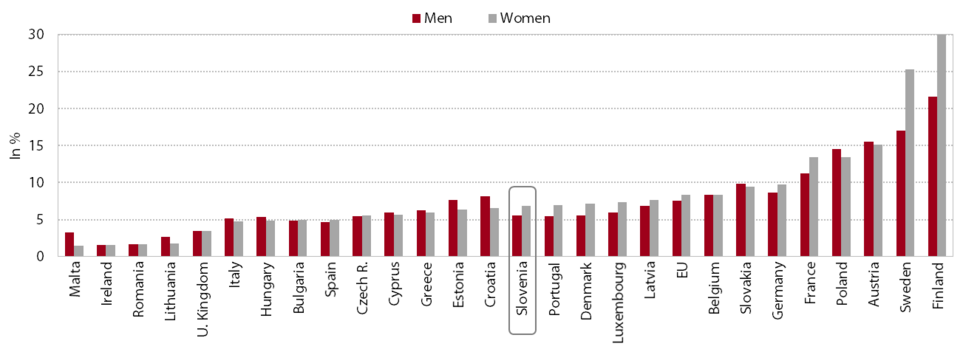
17. Healthy life years
A person born in Slovenia can expect slightly more than 58 years of healthy life, which is significantly less than the EU average. Combining mortality and health status data, the indicator shows the number of remaining years a person of a certain age is expected to live without disability or the need of assistance. In 2010–2015 healthy life expectancy at birth increased by 4.1 years on average in Slovenia (significantly more for men, by 5.1 years, than for women, by 3.1) and by 0.8 years on average in the EU. Following a rapid improvement, in 2015 men could already expect to live free of disabilities longer than women. The gap between people with higher and those with lower education narrowed in 2005–2014. According to the most recent analyses, the gap is roughly the same as the average for those EU Member States for which data are available. Increasing the number of healthy life years in the future would significantly contribute not only to the extension of an individual’s activity, but also to slower growth in health and long-term care expenditure and hence sustainable financing of social protection systems in the long term.
In 2010–2015 Slovenia also reduced its lag behind the EU average as regards expected healthy life years at the age of 65. In 2015 a person aged 65 could expect to live another 7.9 years in a healthy state (one year more than in 2011), compared with 9.4 years in the EU (0.7 years more than in 2010). For Slovenia to further narrow the gap with more developed EU Member States, it will be necessary to increase investment in preventive care.
After a few years of improvement, the ratio of healthy life years to life expectancy deteriorated slightly in Slovenia in 2014 and 2015; in the EU it improved. In all EU Member States the ratio is more favourable for men, though largely as a consequence of their lower life expectancy, as the gender gap in the number of healthy life years is significantly smaller or even reversed than that in life expectancy (in 11 EU countries including Slovenia, men live longer in a healthy state than women). A worse ratio however means higher pressure on social protection systems because of early retirement and higher demand for health and long-term care services.
Figure: Proportion of years lived in good health, 2015
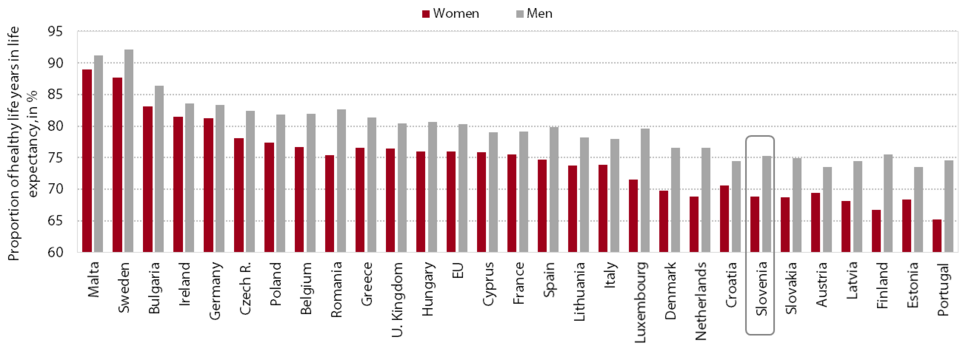
18. Gender Equality Index
Slovenia made significant progress according to the Gender Equality Index (GEI) in the ten years to 2015. The index is calculated based on 31 indicators for six domains: work, money, knowledge, time, power and health. Slovenia advanced by 7.6 scores during this period. With an index value of 68.4, it ranked 10th among EU Member States in 2015. To meet the SDS target (at least 78), it will have to continue progressing at a similar pace.
In the last ten years Slovenia, like many other countries, made the most headway in the domain of power. This is reflected particularly in significant progress regarding the participation of women in decision-making, which is a consequence of changes to election laws (the introduction of gender quotas on candidate lists). Visible progress was also made in most other areas. In most (except for knowledge), Slovenia exceeds the EU average. The indicators show the greatest gap in the domain of knowledge, given that Slovenia has a low share of men studying education, health, humanities and the arts. In both Slovenia and the EU as a whole, women tend to be better educated than men but are less frequently represented in better paying jobs and leadership positions, their average earnings therefore being lower than those of men. Both the pay gap and the gap in employment are however relatively small in Slovenia, which is reflected in favourable results in the domains of work and money. Slovenia, like other EU Member States, saw its scores deteriorate in the domain of time. The European Commission therefore proposed a set of additional directives for the reconciliation of family and professional life, particularly from the aspect of time dedicated to housework and caring for family members.
Figure: Gender Equality Index (GEI)
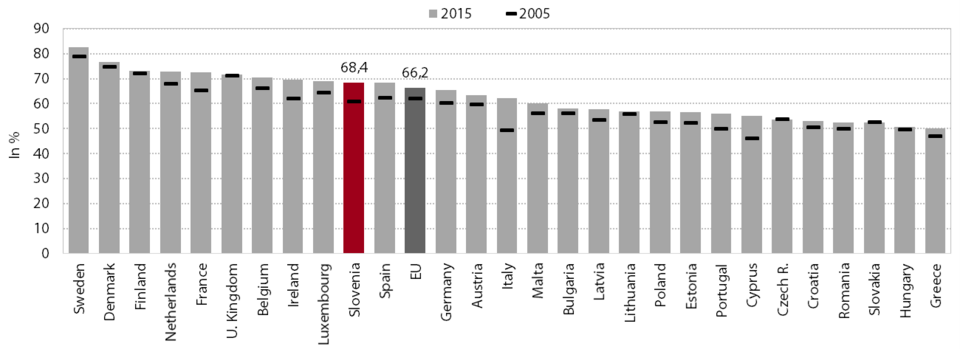
19. Amenable mortality
Amenable mortality has improved since 2011 and was similar to the EU average in 2015. The indicator of amenable mortality shows the number of deaths that could have been prevented in a given year through effective and timely health care. The performance of the Slovenian health system on this indicator improved slightly less than the EU average in 2011–2015. In Slovenia, 9 more deaths per 100,000 inhabitants were prevented in 2015 than in 2011, compared with almost 11 in the EU. The improvement was greater for men, but the lag behind the EU average is still smaller for women than men. Most of the gains (in both Slovenia and the EU) can be attributed to the steadily decreasing mortality caused by heart and cardiovascular diseases and treatment of more types of cancer.
Slovenia has made the most progress in the detection and treatment of breast cancer but could do more to improve cervical cancer treatment and reduce stroke-related mortality. The effectiveness of cancer prevention and treatment improved in 2010–2014, the most for breast cancer, where the 5-year survival rate reached 83.5% in 2014, placing Slovenia in the upper third of EU countries. Colon and colorectal cancer survival rates have also risen, but the survival rate for cervical cancer fell to 65.6% in 2010–2014 even with a comprehensive screening programme in place. In acute care, Slovenia has relatively low 30-day mortality in patients admitted to hospital for acute heart myocardial infarction, but its 30-day mortality rate for strokes in 2014 was one of the highest among Member States for which data are available and almost twice that in Italy and Austria, despite a decline in the last few years.
The number of preventable deaths due to alcohol abuse remains very high, but the number of deaths because of traffic accidents involving alcohol has decreased. Alcohol consumption has dropped somewhat in the last decade but remains very high especially among men; the situation regarding the prevention of alcohol-related deaths is also poor. Particularly mortality from chronic liver disease in men is among the highest in the EU, meaning that further policy measures should be considered to reduce alcohol-related harm. Through drink-driving policies, Slovenia managed to significantly reduce the number of deaths resulting from traffic accidents involving alcohol in the 2011–2015 period. Mortality from external causes has consequently declined, though it is still above the EU average.
Figure: Amenable mortality, Slovenia and EU, 2015
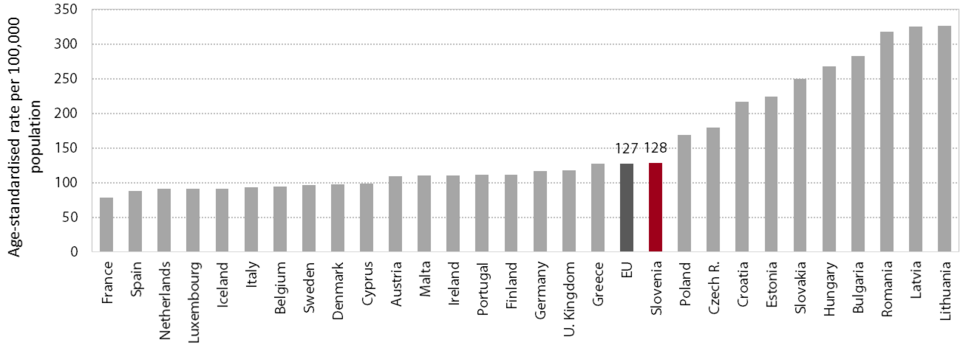
20. Health expenditure
Following a significant decline during the crisis, public health expenditure rose significantly in real terms in the years to 2017. During the crisis public health expenditure had been increasing slightly in real terms up to 2011, before dropping sharply in 2012 and 2013 following the adoption of the ZUJF and other measures for balancing the HIIS budget. The main measures for reducing HIIS expenditure in this period included raising co-payments for health services and medicines, which are covered by complementary health insurance. The latter significantly increased expenditure from complementary health insurance but at the same time also preserved the low level of out-of-pocket expenditure and the relatively good financial access to health services even during the crisis. Since 2014 public health expenditure has been rising in real terms, underpinned particularly by stronger growth in employment and wages and hence higher inflows into the health insurance fund. The stronger growth in revenue in recent years has allowed for the expansion and a more effective evaluation of certain priority programmes (such as model practices, oncology, nursing homes and biological medicines), the reduction of waiting times and the coverage of the increasing expenditure on sickness benefits. In 2017 the additional funds for health care were also due to part of the salaries for physicians in training and those undergoing specialisation being covered from the state budget. According to a first estimate, current public expenditure accounted for 5.9% of GDP in 2016 and 2017; meanwhile the share of public health expenditure in total current health expenditure rose to 72.9% in 2017. The shares of both total and public health expenditure relative to GDP in Slovenia are somewhat lower than the OECD average. In 2015 current health expenditure amounted to 8.6% of GDP, the OECD average being 9.0% (EU: 8.5%). In 2009–2016 expenditure per capita in Slovenia rose by only 0.9% in real terms, while the OECD average increased by 1.4%. In 2016 it was PPS USD 2,835 according to the first estimate, which is only 71% of the average for the OECD (2014: 73%; 2008: 77%).
The measures taken during the crisis have contributed to a change in health expenditure structure. A breakdown of health expenditure movements by function shows a significant turn during the crisis, which was positive in terms of recommendations for restructuring expenditure to increase the efficiency of the system: growth in expenditure on out-patient care strengthened, while expenditure on in-patient care declined. It is however less encouraging that Slovenia lags further and further behind in terms of the share of expenditure on long-term health care, particularly on home-nursing services and attendance allowances for help at home, this not only as the majority of more advanced OECD countries had already intensified public funding for these functions before the crisis, but also as during the crisis Slovenia reduced this expenditure’s growth significantly more than the OECD average. Following an increase in public sector wages, public expenditure on system administration also rose significantly in 2016 and 2017.
Figure: Growth rates of health expenditure by function, per capita
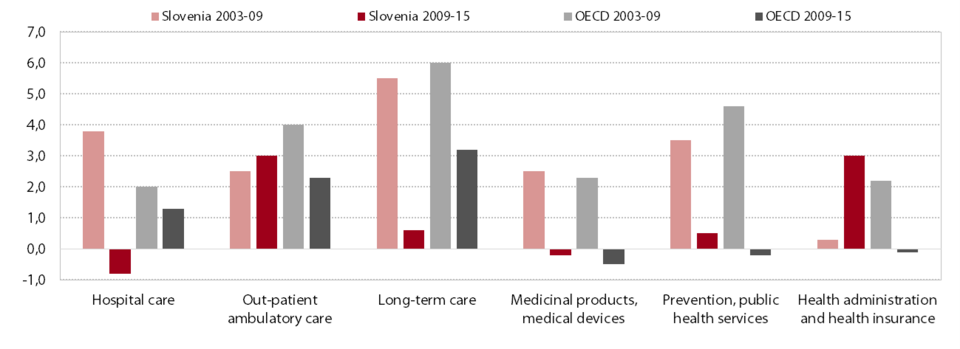
21. Expenditure on long-term care
Slovenia is widening its gap with the OECD average in terms of total expenditure on long-term care (LTC). In the OECD, LTC expenditure is, on average, rising much faster than in Slovenia. Expressed as a share of GDP, LTC expenditure across the OECD increased from 1.1% of GDP to 1.6% of GDP on average in 2005–2015, in Slovenia half less, only from 1.1% to 1.3% of GDP. While LTC expenditure per capita in the OECD almost doubled in the above period, it rose by just above 50% in Slovenia. Moreover, according to sources of funding, the share of public expenditure dropped by as much as 5.0 pps in the ten-year period of 2005 to 2015; broken down by function, there was a decline in the share of expenditure on the health component of LTC, which is mostly financed by public funds (96% in 2015, of which 52% financed by HIIS funds).
In 2005–2015 Slovenia recorded more than half lower growth in public LTC expenditure than OECD countries as a whole and mainly invested in institutional care. Public LTC expenditure in Slovenia rose only by 2.1% per year in real terms, while the OECD average rose by as much as 4.6%. Slovenia saw its gap widen in both the share of public expenditure on LTC health services (2015: Slovenia 0.8% of GDP; OECD: 1.3% of GDP; these mainly include community nursing, nursing allowances and institutional health care) and the share of public expenditure on social LTC services (2015: Slovenia 0.1% of GDP; OECD (16 countries) 0.4% of GDP; particular care at home). While more advanced OECD countries have primarily increased public funding for long-term care at home, Slovenia’s investment in this type of care is minimal and the ratio between institutional care and care at home deteriorates from year to year. In 2015 Slovenia allocated as much as 73% of public expenditure for LTC care in institutions (retirement homes, special social welfare institutions, care and working centres, and hospitals) and only 27% for LTC care at home, the OECD average ratio being 65:35.
Figure: Real annual growth in public LTC expenditure per capita in 2005–2015
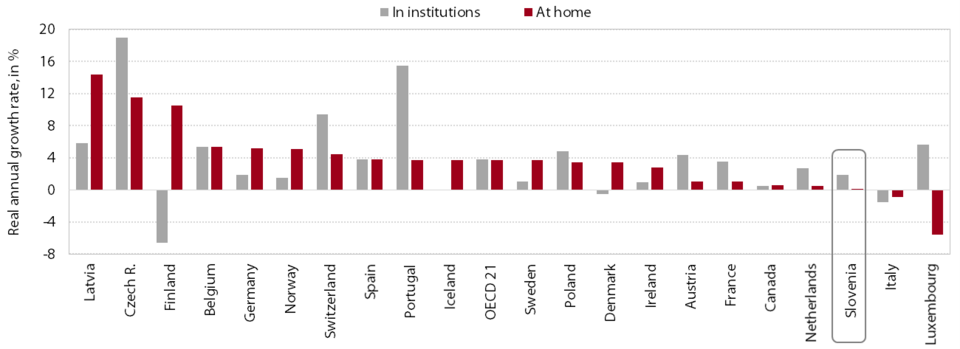
22. Overweight and obesity in adults
The share of obese adults is still significantly higher than the EU average, despite a decline. Overweight and obesity, usually a consequence of excessive food intake and insufficient physical activity, are important risk factors for the development of chronic health conditions and premature mortality. The burden of non-communicable chronic diseases such as hypertension, diabetes and cardiovascular diseases is rapidly rising in the EU and worldwide. Cardiovascular diseases are the main cause of mortality in Slovenia and most developed countries. Obesity moreover has not only medical but also socioeconomic consequences (social exclusion, lower income, higher unemployment and more working days lost). The proportion of overweight persons among adults actually fell in Slovenia between 2007 in 2014, but that of obese person rose and significantly exceeded the EU average in 2014. The proportion of persons overweight, including obesity, among people aged 15 years and over was 55% in Slovenia in 2014, compared with 50% in the EU. Among those over 65 years old, as many as 67% were overweight (EU: 63%), the share of obese people standing out significantly in this age group, at 24% (EU: 20%), while the share of overweight people equalled that in the EU (43%).
Slovenia diverges from the EU average particularly in the high prevalence of obesity in men of all levels of education and women with low education. The differences in overweight and obesity are significantly related to educational attainment. In both 2007 and 2014 the obesity rates were notably higher among persons with lower education (over 23%). The educational gap remained unchanged on average during this period. In 2007–2014, the share of obese adults increased the most among people with an upper secondary education (both women and men) and among men with higher education. Women with higher education tend to be the most aware of the importance of a healthy diet, the share of obese women thus being significantly lower in Slovenia than on average in the EU. In many EU countries (indeed in the majority of OECD countries ), the obesity rate is otherwise higher among women than among men.
Figure: Share of overweight and obese people aged 15 and over, Slovenia and EU Member States, 2014

23. Life expectancy
Life expectancy at birth in Slovenia surpassed the EU average in 2014 and 2015. Life expectancy is higher for women than men (by six years), but in the last few years it has been rising faster for men, reaching the EU average in 2014 (life expectancy for women has exceeded the EU average since 2008). Life expectancy in Slovenia increased by almost three months per year in the ten years to 2015 (in the EU by two). This can be attributed to various factors, such as higher education, better socio-economic conditions, healthier lifestyles and advances in medicine. In general, life expectancy depends on several factors which are intertwined, such as national and personal income, health expenditure, education, lifestyle, and working and living conditions.
Life expectancy at birth is highest in the Osrednjeslovenska region. Women born in the Osrednjeslovenska and Gorenjska regions in 2016 could expect to live for almost 85 years, in the Pomurska region more than two years less. The Osrednjeslovenska region also has the highest life expectancy for men (almost 80 years), while Posavska is the region where life expectancy for men is the lowest. In 2011–2016 the differences between the two regions with the highest and lowest life expectancy dropped for women but increased slightly for men.
Broken down by educational attainment, life expectancy at age 65 is lowest for low-skilled men; other EU Member States also have considerable gender gaps. In Slovenia, women at age 65 can expect to live for a further 21.4 years on average compared with 17.6 years for men. Remaining life expectancy among women with low education is 21.1 years and among those with tertiary education 21.9 years. For men, the educational differences are significantly more pronounced (remaining life expectancy for less educated men is 16.8 years; for those with tertiary education it is two years longer). The gender gap is widest for those with low education, where women can expect to live as many as 4.3 years longer than men. In 2015 life expectancy at age 65 in Slovenia reached the EU average; it is lower for men and higher for women, indicating there is still room for improvement in the lifestyles especially of men. Gender differences in life expectancy by educational attainment are also relatively large for younger people.
Figure: Life expectancy at age 65, by gender and educational attainment, 2015
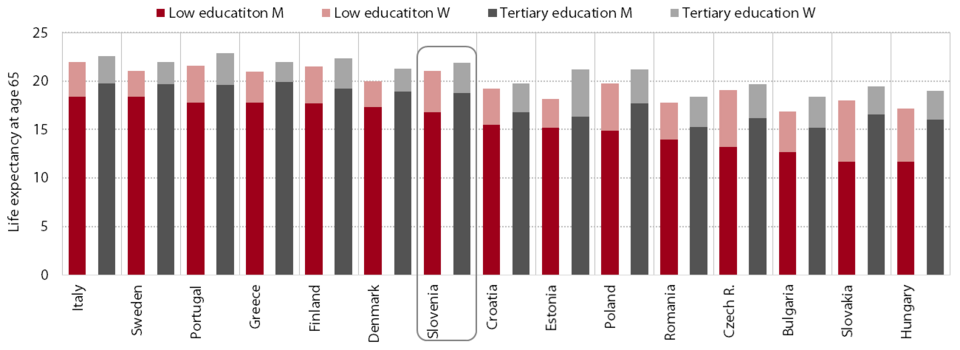
24. Unpaid voluntary work
The proportion of people who carry out unpaid voluntary work on a regular basis is slightly above the EU average. The proportion of volunteers engaged in unpaid voluntary work occasionally and the proportion of those doing it regularly or at least once a month both increased in 2016 relative to 2012. In Slovenia, 34% of respondents carry out some type of unpaid voluntary work, of which 12% on a regular basis. The most volunteers are involved in regular unpaid voluntary work through educational, cultural, sports or professional associations (11.3%) and other voluntary organisations (5.6%), more than in 2012 and more than on average in the EU. The proportion of volunteers is the highest among young people (18–24 years) and more voluntary work is carried out by men. The proportions of respondents doing voluntary work at least every month in community and social services (3.9%), social movements (2.4%), and political parties and trade unions (1.1%) are lower (and also lower than the EU average). The proportions of those volunteering in community and social services and political parties and trade unions are the highest in the 25–34 age group; the proportion is slightly higher for men. Women perform more voluntary work through social movements, the proportion of those involved in regular voluntary activity being the highest in the 65+ age group.
Figure: The proportion of people doing unpaid voluntary work through educational, cultural, sports or professional associations, 2016
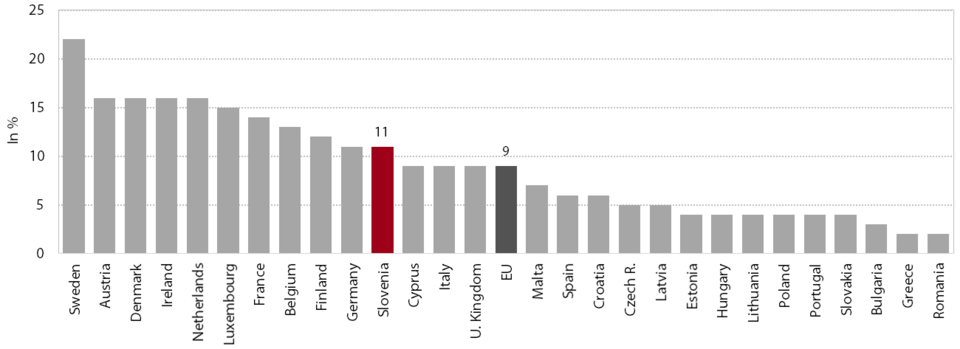
(copy 2)
1. Resource productivity
The resource productivity of the economy, having risen sharply with reduced construction activity during the crisis, continues to improve. Productivity expressed as a ratio of GDP over material consumption had been rising faster than in the EU overall in 2007–2012, then followed rather closely the fluctuations of construction activity and, consequently, the consumption of non-metallic mineral products. In 2016 Slovenia ranked in the middle third of EU Member States on this indicator. It lagged 15% behind the EU average, which is not much considering the significant divergences between individual Member States. Owing to the rebound of construction activity in 2017, it can be assumed that productivity growth eased again. Slovenia will be able to achieve the SDS goal, i.e. a further increase in material productivity, assuming that it retains roughly the same growth as in the past 15-year period (i.e. a slightly higher GDP growth and a slightly faster decline in material consumption than in the EU), whereby material productivity would reach the EU average in the target year.
Material consumption per capita and its structure in Slovenia are comparable with the EU average. Material consumption had been rising until the onset of the crisis, then fell sharply and is now around two-tenths lower than at the beginning of the previous decade. The level of material consumption was significantly affected by economic activity, particularly in construction, a sector that uses a large amount of raw materials, particularly gravel and sand. In the breakdown of domestic resources, 52% is sand, gravel, limestone and gypsum, 18% crop residues, and 15% each lignite and wood. The proportion of biomass is slightly lower and the proportion of non-metallic minerals slightly higher than in the EU as a whole. Lower material consumption per capita than in Slovenia is recorded by only ten EU Member States, meaning that Slovenia is not a very wasteful country in terms of raw materials consumed.
Slovenia’s self-sufficiency in terms of raw materials rose relative to the pre-crisis level and is slightly higher than the EU average. Like most other EU Member States, Slovenia is a net importer of raw materials, its imports accounting for around 13% of consumption (in the EU overall 3 pps more). While the bulk of net imports are oil derivatives and gas, in the last few years following the glaze ice damage, net exports of wood have risen significantly. This is favourable from the aspect of material consumption, though economically less desirable from the aspect of efficient use of the scarce domestic resources, where value added could be created by domestic manufacturing industry. While most EU Member States are net importers particularly of raw materials, the bulk of Slovenia’s net imports are processed materials (more than half of EU Member States are net exporters of such materials).
Figure: Resource productivity and material consumption per capita, 2016
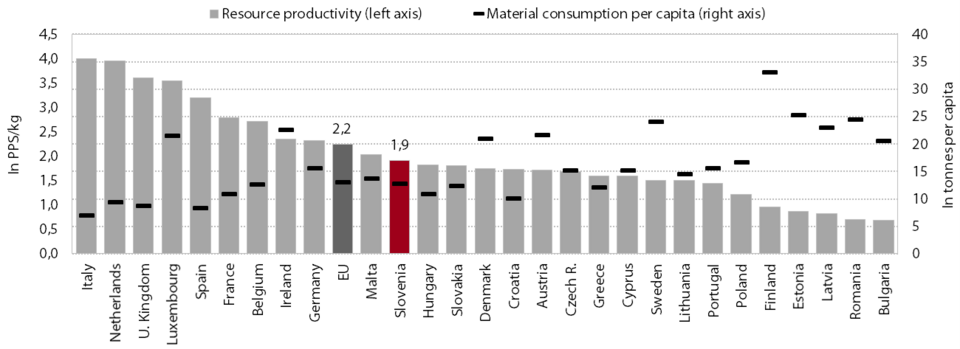
2. Share of renewable energy sources in final energy consumption
The share of renewable energy sources (RES) in final energy consumption is above the EU average, but it has more or less stagnated for the last several years. In the last decade it rose more markedly only in 2009, when final energy consumption fell by almost one-tenth because of the crisis while RES consumption increased by around one-fifth. Up to 2016 it had only grown by around another 1 pp. The interim minor changes in the share were due to fluctuations in RES consumption for heating (owing to milder winters) and the use of hydro power (owing to great differences in annual river levels); in recent years the growth of RES consumption has also been impeded by declining consumption of biofuels. In terms of the share of RES, Slovenia ranks just behind the first third of EU Member States, while it is in the last third according to its growth. Between 2004 and 2016, RES consumption rose by one-third in Slovenia while doubling in the EU. For Slovenia to reach its long-term goals for increased consumption of RES, more radical moves will be required, alongside activities to facilitate and shorten the siting procedures.
Slovenia still has a relatively large share of traditional RES but a significantly lower consumption of other RES. Traditional RES (solid biomass and hydropower) still account for around 90% of total RES consumption in Slovenia, compared with less than 60% in the EU overall. The extensive consumption of biomass, which is mainly used for heating, is however not favourable from the point of view of particle pollution. The share of other RES (wind, solar and geothermal energy, biofuels, heat pumps, and biogas) is among the lowest in the EU. Slovenia lags behind the EU average particularly in the use of wind farms and heat pumps, which account for almost one-fifth of RES consumption in the EU. The share of RES in transport is also significantly below the target, but since the adoption of a new decree, distributors are a much greater extent bound to increase the share and approach the target level.
Within the support scheme for electricity from RES, in recent years as much as three-fifths of support has been granted for solar energy. The most support per unit of power generated being given to solar energy production (supports are also provided for electricity generation from biogas, wind, biomass and hydropower plants), the expansion of the share of solar power production in the 10-year period since the scheme was established also led to a significant increase in the average amount of support per unit of electricity generated (in comparison with the beginning of the ten-year period, when support for small hydropower plants predominated).
Figure: Share of RES in final energy consumption, 2016
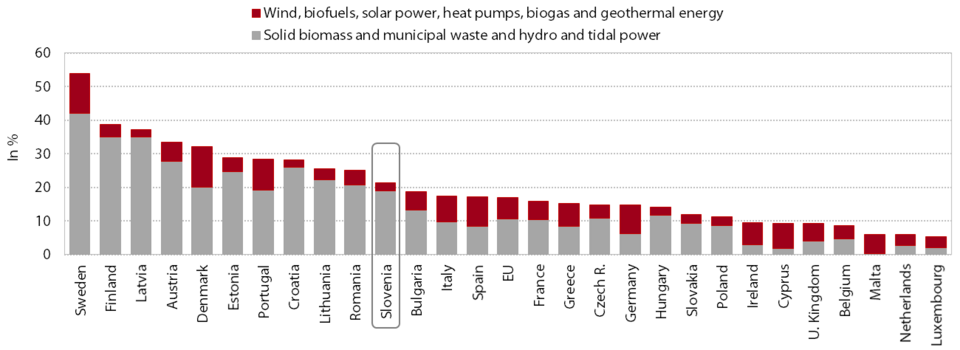
3. Emission productivity
The emission productivity of the economy, though rising, still lags behind the EU average. After increasing in times of economic growth owing to faster growth in GDP than greenhouse gas (GHG) emissions, productivity as measured by the ratio of GDP to GHG emissions remained almost unchanged in the first years of the crisis. However, as the EU average increased further during the crisis, Slovenia saw its gap with the EU widen. In 2014 and 2015, on the other hand, productivity improved faster in Slovenia than in the EU overall. The gap with the EU narrowed significantly and in 2015 Slovenia generated around 13% less GDP per unit of GHG emissions than the EU average.
Having declined during the crisis, the volume of GHG emissions has again been slightly rising in recent years. After increasing relatively fast during the times of economic boom, emissions dropped owing to the crisis and the shutdown of one of the thermal power plants. In 2014 they were around one-quarter lower than their peak in 2008. In 2015 they rose somewhat again, largely owing to the consumption of fuels by industry. According to preliminary data, they increased further in 2016, with emissions from transportation (accounting for one-third of total emissions) alone growing by around 6%.
Over the longer term, emissions have been falling across all sectors but transportation. The total decline was mainly due to the energy sector. The fall in this sector, where emissions are almost entirely due to thermal electricity generation, followed the shutdown of one of these plants. The top position in terms of emissions is now occupied by the transport sector. Transport emissions had been rising relatively rapidly during the time of economic growth, then fell somewhat during the crisis, though remaining high by international comparison. Since 1990 they have nearly doubled, in part owing to strong international trade flows through Slovenia and the relatively favourable competitive conditions established through tax policies such as the refund of excise duties. Approximately one-fifth of total emissions come from agriculture and the consumption of fuels in industrial processes, the share of emissions from other activities being relatively modest. The main component of GHG emissions is carbon dioxide, which is generated mostly by the combustion of fuels; this is followed by methane and dinitrogen monoxide, which mainly derive from agriculture and landfilled waste.
Figure: Emission productivity, 2015
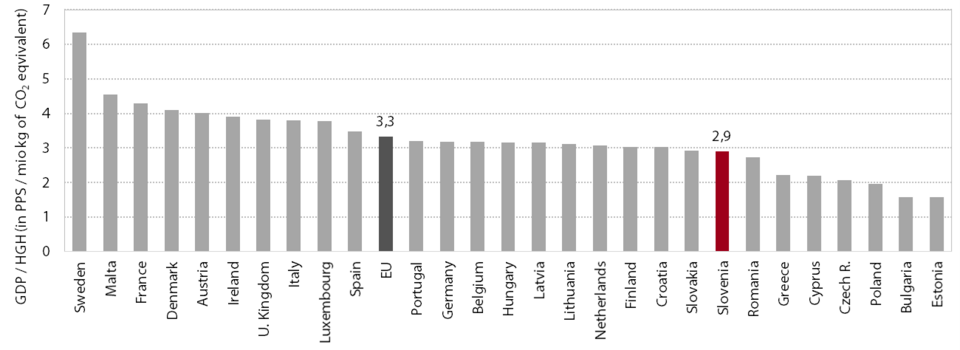
4. Energy efficiency
Primary energy consumption has declined by around one-tenth in Slovenia in the last few years but, judging by the year 2016, may start increasing again with higher GDP growth. Energy efficiency has thus been rising, meaning that energy consumption is being reduced compared with the projected consumption under the no-policy change scenario. A faster decline in energy consumption is impeded by high energy consumption in transport, which significantly contributed to the renewed increase in total energy consumption in 2016 (by 3.4%). For Slovenia not to exceed the 2020 energy efficiency target, energy consumption should not increase by more than 2.2% per year in the four years to 2020.
Though mostly rising, energy productivity has fallen somewhat behind the EU average in the last few years. The growth of energy productivity (defined as the ratio of GDP to total energy consumption) eased more notably (and also declined) only in the first years of the crisis. The lag behind the average energy productivity in the EU rose in this period from around 15% to around 20%.
Final energy consumption is significantly influenced by high energy consumption in transport and, in recent years, fluctuations in the use of energy for heating. After falling from 2008, final energy consumption rose sharply in 2015 and 2016, meaning that it remained almost unchanged in the 2005–2016 period as a whole (in the EU it dropped by one-tenth during this period). Broken down by sector, energy consumption fell considerably only in industry, while rising notably in transport, mainly owing to increasing transit through Slovenia. The decline in household consumption was attributable to the mandatory installation of heating cost dividers, more efficient heating appliances and energy renovation of buildings and, even more, to higher temperatures during the heating season especially in 2014. In 2015 and 2016 winter temperatures were again lower and, in turn, energy consumption higher.
Figure: Final energy consumption by consumer sector
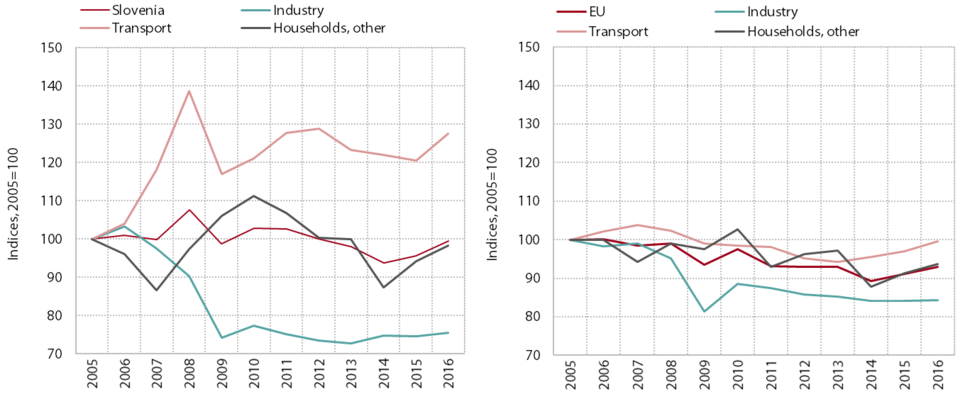
5. Modal split of transport
In the previous decade the share of road freight transport in total freight transport was rapidly rising and was significantly above the EU average, but in the last few years the gap has been narrowing. In the previous decade freight transport by road had been rising much faster than freight transport by rail, but in 2009–2016 freight transport by rail increased twice as much as transport by road. It was also rising faster than road transport in 2017, the share of road transport thus dropping below 80% according to our estimate. In the EU – where Slovenia ranks below the upper third of Member States – this share is a few percentage points lower, although it has been rising in recent years. From the environmental perspective, an even faster shift from road to rail transport is desirable, to which the construction of the planned second track of the Divača–Koper railway would contribute. Slovenia has very high levels of both road and rail freight transport per inhabitant (2.5-times as high as the EU average), primarily owing to its transit location and the density of road and rail transport infrastructure. Traffic intensified especially with the recent enlargements in the EU and the completion of Slovenia’s motorway network.
Slovenian hauliers perform more and more of their activities abroad; at the same time, more and more foreign hauliers operate on Slovenian roads. This trend has to do with the liberalisation of transport in the EU and the competition of hauliers from different Member States. In 2016 the distance of journeys performed in the territory of Slovenia again approached the high level from 2008 (in the interim it had declined due to the crisis, the most in 2013, this by one-tenth). The distance of journeys performed by Slovenian hauliers abroad (i.e. cross-trade) increased by around a half, while their journeys that are at least partly connected to the territory of Slovenia dropped by around one-seventh. This indicates an increase in transport activities by foreign hauliers on Slovenian roads, which is also confirmed by data from toll stations. According to the latest data, in 2008–2012 alone the share of foreign freight vehicles on Slovenian motorways rose by 15 pps to 68%, and it is still rising.
Passenger transport is marked by a high reliance on the use of passenger cars. Slovenia has one of the highest shares of transport by passenger car in total passenger transport in the EU. This is in part attributable to the diversity of its landscape and its dispersed settlements, which – in spite of subsidies – makes it difficult to extend the network of public transport and increase its profitability. According to a 2012 survey, one-quarter of Slovenians have 'high’ or ‘very high’ levels of difficulty in accessing public transport (more people have difficulty in accessing public transport in only four other EU Member States; in the EU as a whole the share is one-fifth). People with lower incomes and those living in remote rural areas tend to have the most problems in accessing public transport. Under such conditions, passenger transport is generally also more expensive. The share of transport expenditure in total household expenditure in Slovenia is the highest among all EU Member States.
Figure: Passenger transport, in %
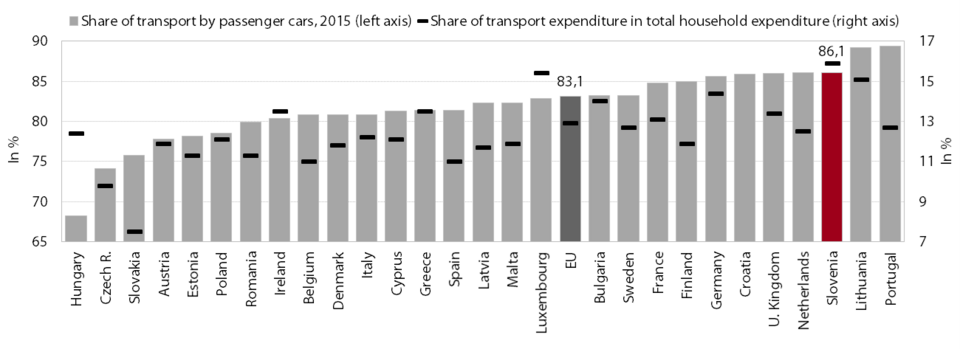
6. Waste
The quantity of total waste generated, which was declining during the crisis, has been rising in the last few years. In 2016 the quantity of waste was, for the fourth consecutive year, higher than one year previously and around one-quarter higher than in 2012. Waste from production and service activities, which accounts for four-fifths of total waste, was rising more slowly during this period. The vast majority – around nine-tenths of waste – is usually generated by four sectors: (i) manufacturing, (ii) construction, (iii) electricity, gas and steam supply, and (iv) water supply, sewerage, waste management and remediation activities. The largest share is accounted for by construction waste, as this has a high specific weight. The remaining fifth is municipal waste, i.e. waste from households and other waste of similar origin managed by the providers of mandatory municipal public services for environmental protection. The quantity of this waste increased by one-third in 2012–2016 and approached the EU average. Hazardous waste, where chemical compounds and other chemical waste predominate, account for 2% of total waste generated.
With increased waste recovery, the quantity of landfilled waste is decreasing relatively rapidly. The total quantity of waste recovered in 2016 was around three-quarters higher than a decade before. Recycling, a very desirable form of recovery from an environmental perspective, has risen slightly in recent years, but it is still significantly lower than during the crisis. In the period since the crisis, its share has more than halved, to 46% of total recovery. Landfilling, which is the least favoured option in the waste management hierarchy, continues to be successfully reduced. Having been rising until the crisis, the quantity of landfilled waste then dropped sharply and accounted for only 2% of the total amount recovered in 2016. The share of landfilled municipal waste also continues to decrease, as more than two-thirds of municipal waste is already collected separately and as residual mixed municipal waste must be treated before going to landfill; in 2016 it totalled around 8%.
In the area of municipal waste, Slovenia performs better than the EU as a whole. Despite the increase in recent years, the quantity of municipal waste generated per person is close to the EU average, though still slightly lower (in 2016 by 14 kg or around 3%). Waste management structure in Slovenia is also better than in the EU as a whole, a larger share of municipal waste being recycled (in Slovenia 54%; in the EU as a whole 46%) and a smaller share landfilled. However, as many as six EU Member States have already reduced their shares of landfilled municipal waste to below 3% of total waste generated.
Figure: Municipal waste generated and landfilled, 2016
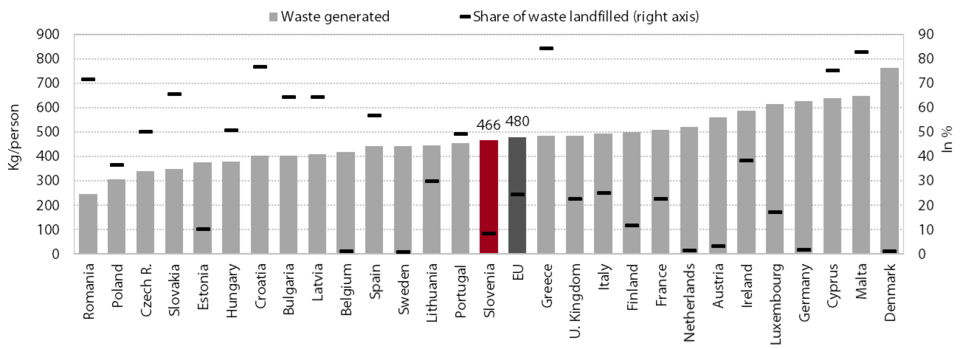
7. Environmental taxes
In the last few years, the level of environmental taxes has been stable and higher than before the crisis. The rise in environmental taxes – which include energy taxes, transport taxes, and taxes on pollution and the use of natural resources – in 2008–2016 (from 2.95% of GDP to 3.87% of GDP) arises from the increased taxes on energy, which accounted for 85% of all environmental taxes in 2016. This is primarily a result of the higher amounts of excise duty on energy (motor fuels) in 2009 and 2012 and the introduction of a CO2 tax on energy in 2012, which mitigated the decline in general government revenue in the first years of the crisis. Over a longer period (2000–2016), this also led to an increase in the effective tax rate on energy consumption amid a decline in the effective tax rate on employed labour. In 2016 revenues from transport taxes and taxes on pollution and the use of natural resources reached the same nominal values as in 2008, their share in total environmental taxes falling to 15%. In spring 2017 the Government started to prepare a strategic development project, the Green Budget Reform, which is aimed at better aligning tax policy measures with environmental goals. It focuses on an overview of various subsidies and tax breaks with regard to their impact on the environment. Subsidies that do not help lower the environmental burden include, for example, the existing refunds of excise duties for commercial and industrial-commercial purposes, exemptions from the payment of excise duties for energy-intensive companies, lower excise duties on diesel than on unleaded petrol, and exemption from the payment of taxes on CO2 emissions. The effectiveness of environmental taxes to protect the environment is, besides by subsidies which are not contributing to the reduction of environmental harm, also impaired by the ineffectiveness of the European Emissions Trading Scheme, with many companies being allocated more CO2 emission allowances than they actually need; moreover, in recent years the effect of higher taxes on oil consumption and incentives for the use of cleaner energy sources was also reduced by falling oil prices.
Revenue from environmental taxes as a percentage of GDP had already exceeded the EU average before the crisis. Already in 2008 the gap between the levels of environmental tax revenues in Slovenia and the EU as a whole arose from higher purchases and consumption of energy in Slovenia, which is related to the latter’s large volume of transit traffic, strong transport sector, extensive use of motor fuels due to dispersed settlement and poorly developed public transport infrastructure. With a considerable increase in the level of excise duty on energy in Slovenia, much greater than the EU average, the share of environmental taxes in GDP has risen even more than in the EU as a whole since 2008.
Figure: Revenue from environmental taxes, 2016
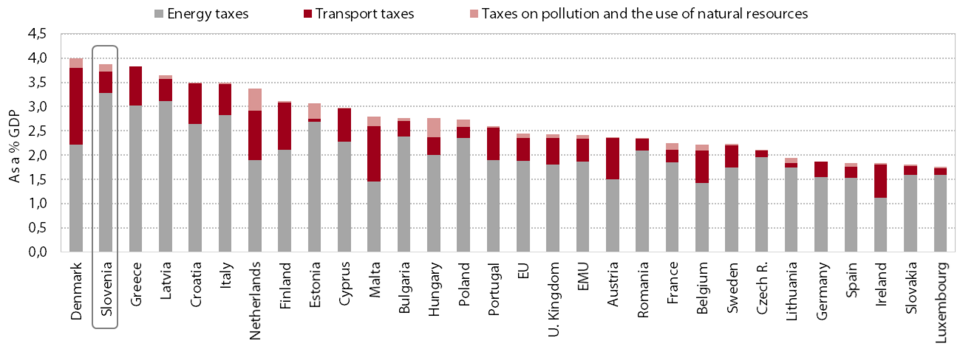
8. Utilised agricultural area
Agricultural area in Slovenia accounts for less than one-quarter of the total area and this share is decreasing. The utilised agricultural area (UAA) covers around 480,000 hectares and is decreasing over the long term. Since 2005 alone it has decreased by 6.5%, around 2 pps more than in the EU as a whole. The decline is mostly due to the abandoning of agriculture and the consequent overgrowth of land by trees and shrubs. Forests cover approximately two-thirds of the total land area, which places Slovenia among the most forested countries in the EU. The share of other land categories, which is high particularly in countries with a lot of infertile land or with high population density, is relatively low in Slovenia.
In the structure of agricultural land, permanent grassland (meadows and pastures) predominates, there being relatively little arable land. Permanent grassland constitutes around six-tenths of the total agricultural area, which is to a great extent a consequence of natural conditions. The relatively large total production of fodder crops is also reflected in the relatively large share of livestock breeding in Slovenia’s agriculture. Since 2005 permanent grassland has declined the most of all categories of agricultural land, this by around one-tenth. The area taken up by fields, which is relatively low, has also decreased further, although this type of land is vital for food production. Slovenia is one of the EU countries with the least arable land per person, at 8 ares (it is less than 10 ares in only five Member States). The share of fields dedicated to vegetables is particularly low. The area taken up by permanent crops is relatively stable (around 6% of agricultural area; owing to natural conditions, vineyards predominate).
Organic farming, the best form of agricultural production from an environmental perspective, is more widespread in Slovenia than in the EU as a whole. Around 5% of all agricultural holdings were involved in controlled organic farming in 2016, this on an area of around 44,000 hectares or around 9% of the total agricultural land. This is more than on average in the EU and the share is relatively rapidly rising. Permanent meadows and pastures dedicated to the production of fodder crops account for by far the largest share in the structure of this land, the shares of other categories being relatively low. This is not in line with consumer demand, however, which is greatest for fresh vegetables, fruit and vegetarian processed food. There is still significant room for development of organic farming in Slovenia, given its natural conditions, i.e. the high share of farms in mountainous and other remote areas where intensive conventional farming is not possible.
Figure: Share of utilised agricultural area (UAA) in the total area of countries, 2015
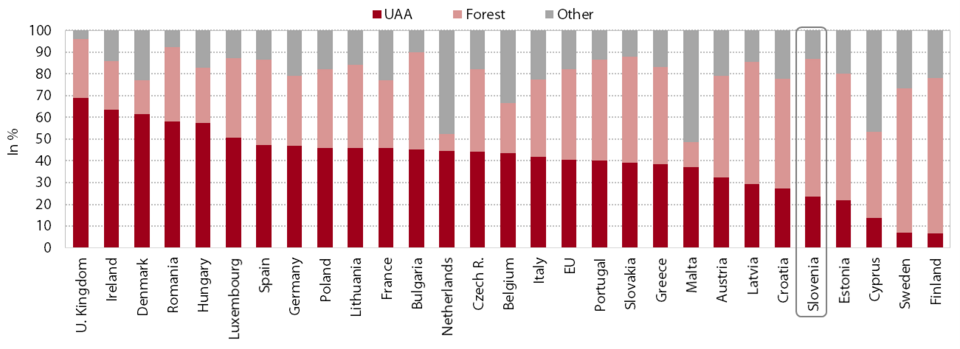
9. Quality of watercourses
Slovenia is a country rich in water resources. The high freshwater supply is a consequence of Slovenia’s diverse natural conditions. The abundance of water is also indicated by the amount of freshwater resources available per capita. its long-term average totalling around 15,600 m3, almost twice as much as the EU average; it is higher in only four Member States. However, Slovenian watercourses are characterised by significant fluctuations in annual flows, which is attributable not only to climatic factors, varied topography and geological structure of the land, but also to human interventions. Despite the abundance of water, Slovenia thus also has to cope with water shortages and floods.
A great majority of water is abstracted from surface water sources; around one-tenth of wastewater is not treated before discharge. Around 890 million m3 of water in total was abstracted in 2016, three-quarters of which was from surface waters and used primarily in industry and for irrigation. The remainder was abstracted from groundwater. Most of it was intended for the public water supply system, i.e. final consumers such as households, kindergartens, schools and other activities. Around 900 million m3 of waste water was discharged to the environment. Approximately one-tenth of this water was discharged without treatment and approximately one-fifth was treated, while the remaining majority was polluted only by heat (used mainly to drive turbines in hydropower plants). Around three-quarters of wastewater was released into surface waters directly, the remainder mostly through the public sewerage system
The quality of rivers, as measured by biochemical oxygen demand, is relatively good in Slovenia; the concentrations of nitrates in groundwater and phosphates in rivers are also below the EU average. At the beginning of the previous decade, the value of the first indicator was above the EU average in Slovenia owing to the relatively high organic pollution. This is usually a consequence of municipal and industrial waste water discharges and runoff from agricultural land. After 2005 the value of this indicator dropped substantially owing to the improved wastewater treatment and the abandonment of economic activities whose waste waters had been a significant source of pollution in previous years. According to the latest data (for 2012), Slovenia performed the best of all EU countries for which data are available in this regard. The concentrations of nitrates in groundwater and phosphates in rivers are also declining and are lower than the EU average.
Figure: Biochemical oxygen demand in rivers
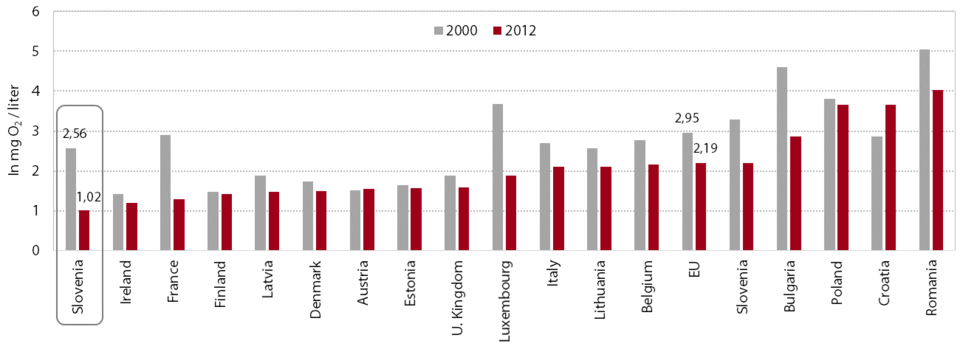
10. Ecological footprint
The ecological footprint, a composite indicator of environmental development, is relatively high in Slovenia and similar to the EU average. It is expressed in standardised units of biologically productive area, i.e. global hectares (gha). The biologically productive area is the fertile area needed to satisfy human needs for food and a particular lifestyle and to absorb or dispose of the wastes generated in the process. The largest component of the ecological footprint is (i) the carbon footprint, which is a result of high carbon dioxide and other GHG emissions. This is followed by (ii) the biological footprint, i.e. the footprint of cropland, forestland, grazing land and other fertile areas, and (iii) the footprint of built-up land (infrastructure). The ecological footprint in Slovenia declined during the recession, following a rapid increase in the period of economic growth. In 2014 it was at approximately the same level as in 2001, similar to the EU average yet larger than in most neighbouring Member States (being larger only in Austria). This indicates economic development amid a relatively high level of natural resource use and environmental pollution.
The ecological footprint should be compared with biological capacity (biocapacity), which is considerable in Slovenia due to its high share of forest area. Biological capacity, i.e. biological areas with regeneration capacity, is also expressed in global hectares. Each global hectare produces the same quantity of biological materials, its productivity thus equalling the average productivity of the total biologically productive area. Biocapacity is significantly more stable than ecological footprint and does not change significantly from year to year. The bulk of Slovenia’s biocapacity is accounted for by forests, but despite their large area they do not suffice to absorb carbon dioxide emissions, the largest contributor to the ecologic footprint.
The difference between ecological footprint and biocapacity has been decreasing in Slovenia since the crisis but is still relatively significant. Calculations show that the difference between the two (i.e. the ecological deficit) in Slovenia is higher than the EU average. With the current lifestyle in Slovenia, 2.8 planet Earths would be needed to provide the resources we use and to absorb our waste.
Figure: Ecological footprint and the ecological deficit/reserve, 2014
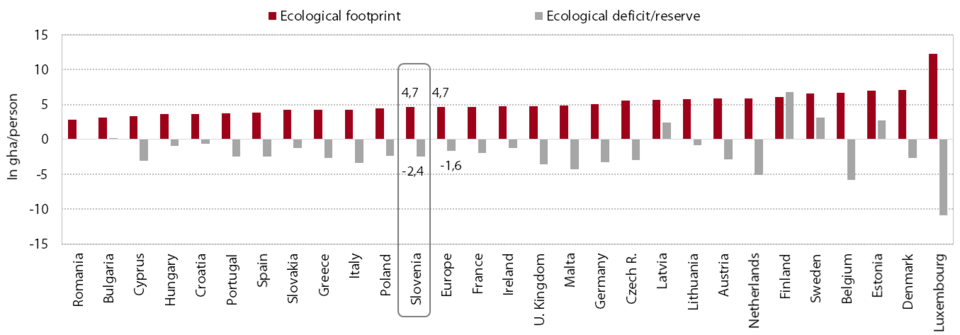
11. Air quality
The quality of ambient air in Slovenia is strongly related to excessive particulate matter (PM) pollution, which in turn reflects the needs for heating and the wind pattern of the area. Exceeding the PM daily limits is typical for the cold part of the year when there are prolonged temperature inversions. Particle pollution during the heating season is mainly due to emissions from households' outdated wood biomass furnaces, followed by particle emissions caused by energy use in industry and transport, particularly diesel-fuelled vehicles. Particulate matter concentrations in Slovenia are highest in poorly ventilated basins, where even relatively low emissions can cause excessive pollution. The general exposure of the urban population to particle pollution, having been declining in the last few years, partly also as a result of milder winters, rose slightly again according to the most recent data for 2015. Household particle emissions have increased, contributing around 70% of total emissions, as have emissions caused by energy production. Average annual PM10 and PM2.5 concentrations are relatively high and significantly higher than the EU average.
Another problem is the locally high presence of ground-level ozone. As the formation of ozone requires sufficient sunlight, the excessive concentrations of ozone – in contrast to particulate matter – mainly occur in the summer months. They are primarily the result of road traffic, the main source of ground-level ozone precursors. The ambient concentration of ozone in Slovenia (which is significantly affected by transboundary air pollution and highly dependent on winds from the west) is the highest in the Primorska region. Owing to strong dependence on weather conditions, the multi-annual series of data does not indicate a clear trend. In recent years the urban population’s exposure to ozone has decreased, but is still higher than the EU average.
Figure: Urban population exposure to PM2.5, 2015
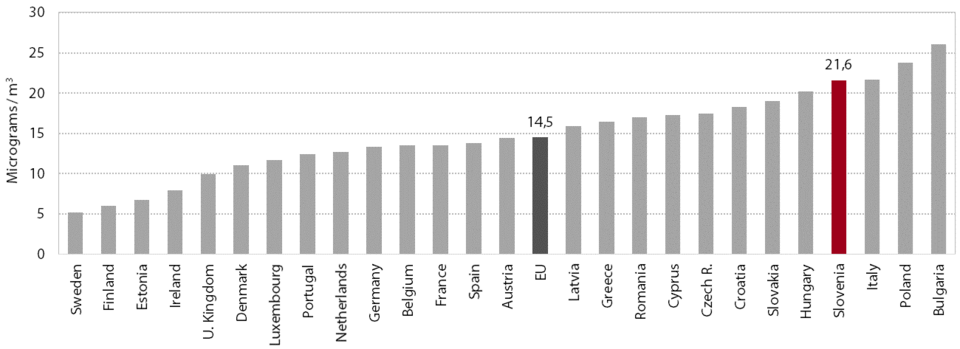
12. Agricultural intensity
The consumption of main agricultural inputs, mineral fertilisers and pesticides, has declined significantly over the long term, but since 2013 particularly the consumption of pesticides has again been rising. The decline had been similar for both inputs, only that fertiliser use ceased to fall somewhat earlier. Agricultural producers had been reducing fertiliser use until 2009, when one-third less main macronutrients (NPK, i.e. nitrogen, phosphorus and potassium, fertilisers) per unit of utilised agricultural area (UAA) were used than a decade earlier. After that, fertiliser consumption per unit of UAA rose slightly and was roughly the same in 2016 as in 2008. The total quantity of all active ingredients in pesticides sold had been declining, albeit with significant annual fluctuations, until 2013, when it was also around one-third less than ten years before. In the following three years it returned to a level similar to that in 2009. The consumption of both inputs is higher than the EU average, but international comparisons are difficult to make, particularly for pesticides, where the figure on the quantity sold is the sum of active ingredients with different toxicity levels.
Slovenia is not among countries with high farming intensity as measured by yield and number of animals per unit of agricultural area. The average yield per hectare for Slovenia’s two most important crops, wheat and grain maize, is rising. An increase in the yield – as long as it is not too large – may be a sign of better exploitation of natural resources than in previous years. A comparison with the EU, however, paints a different picture. The yield per hectare tends to be lower than the EU average for wheat and higher for maize, but in maize the annual fluctuations due to weather conditions are more pronounced. The environmental burden of livestock production as measured by the number of animals per unit of agricultural area (which is relatively high in Slovenia partly as a result of its natural conditions) has declined slightly according to the latest survey results. The relatively low average milk yield per animal is therefore rising, which is favourable from the perspective of the environmental burden per unit of GDP generated. A long-term improvement in agricultural efficiency is related to a decline in the number of agricultural holdings and the concentration of crop and animal production, this contributing to the desired sustainable productivity growth.
Of particular importance is organic farming, which is increasing yet still lags significantly behind the level planned. Around 5% of all agricultural holdings were under the organic farming control system in 2016, only one-third of the targeted 15%. Approximately 9% of the utilised agricultural area was cultivated organically (target: 20%; see Indicator 4.8), the share of all organic products sold on the market standing at around 1% (target: 10%). Moreover, nor does the structure of organic production meet the demand, meaning there is still significant room for improvement in this area.
Figure: Number of livestock units per hectare of utilised agricultural area, 2013
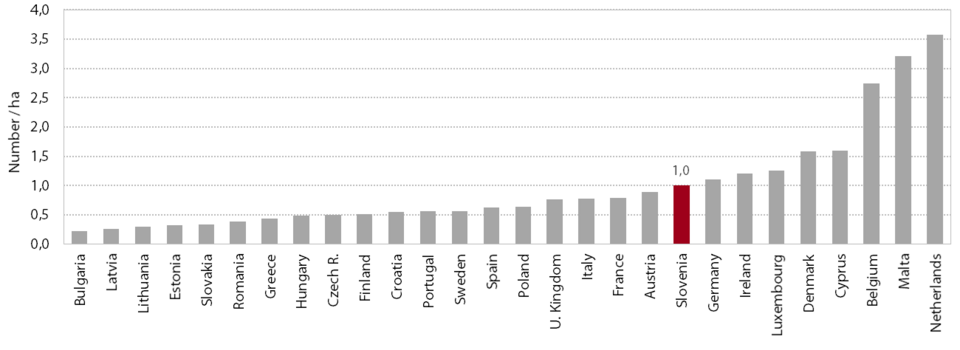
13. Intensity of tree felling
Tree felling has been increasing over the long term, but in the last few years it has been particularly pronounced as a result of emergency removals in the aftermath of the ice storm. Following the severe glaze ice damage in early 2014, around half more wood mass has been cut in Slovenian forests per year than in previous years and twice the amount felled at the beginning of the previous decade. In the last few years annual tree felling has come close to the maximum felling level determined in forestry management plans, having previously lagged considerably behind. The relatively low tree felling intensity, expressed as the rate of annual felling to annual wood increment, has risen to more than 70%. This is close to the level envisaged in the Action Plan, according to which tree felling intensity could be increased to 75% and 6.5 million m3 could be cut without jeopardising sustainable development. However, the structure of cut wood has changed following the ice damage: felling for tree-tending purposes, which normally accounts for the largest share and was on the rise in the previous decade, has declined, while the scope of sanitary cuts has risen notably. In 2015 and 2016 the severe tree damage caused by the ice glaze was exacerbated by the rapid spread of the spruce bark beetle. As a result, three times as much wood had to be cut as ten years before, when the spruce bark beetle had previously caused the greatest tree damage until that time. Sanitary fellings because of the ice glaze damage are however not yet completed.
The increased felling is reflected not only in higher production of raw wood categories but also in rapidly rising exports particularly of the highest-quality wood, which is an untapped potential for Slovenia. The utilisation rate of felled wood measured by the ratio between the production of raw wood categories and felled wood dropped in the first year after the ice glaze damage, before improving again in the following years. After the ice damage, production increased for all wood categories, particularly pulpwood, but also sawlogs and veneer logs, which is the highest-quality wood and generates the highest value added. At the same time, external trade in unprocessed wood increased much more than its total production. While imports of unprocessed wood dropped by almost a fifth, exports thereof almost doubled. Exports of the highest-quality wood rose steeply. Particularly the exports of this wood category rose considerably more than production. The share of total export-oriented wood production rose by 12 pps, while the share of the highest-quality wood alone rose by 13 pps more, to 65 % of total unprocessed wood exports. The rapidly rising exports of this high-quality raw material represent a lost opportunity for Slovenia to increase employment and achieve higher value added in other sectors up the forest–wood chain.
Figure: Intensity of tree felling, 2010
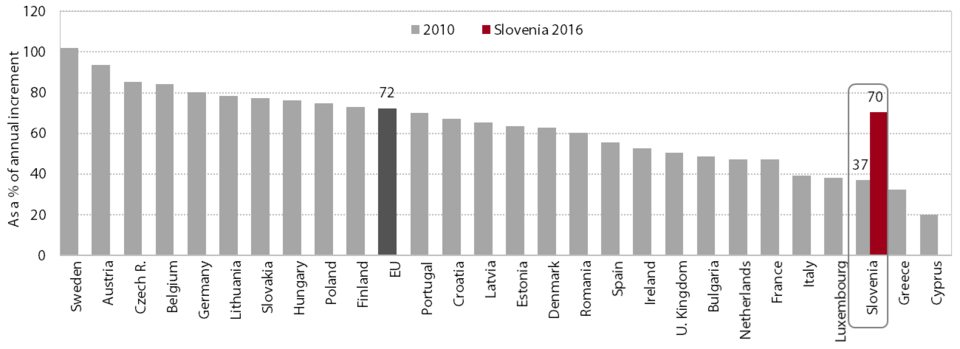
14. Functionally derelict areas
The spatial pattern of functionally derelict areas reveals the great extent of functionally degraded land in Slovenia. Although land degradation is usually mainly associated with explicitly urbanised areas, functionally derelict areas (FDAs) have been identified all over Slovenia, which indicates increasing encroachment of various activities into rural areas. In 2017, 1,081 FDAs were recorded in Slovenia, in a total area of 3,423 ha . The majority, around one-fifth in terms of number or one-third in terms of surface area, are sites degraded by former industrial and commercial activities. The average FDA size is 3.2 ha, FDAs of industrial and commercial activities being the largest (5.1 ha) and FDAs for housing the smallest (1.1 ha). The total area of derelict land differs significantly between regions. It is largest in the Osrednjeslovenska region, which is characterised by the most intense development dynamics, followed by Jugovzhodna Slovenija and Posavska, and smallest in Koroška and Pomurska. FDAs are in as many as four-fifths of Slovenian municipalities (even in many small ones).
An overview of rehabilitation plans for functionally derelict areas shows that a development plan is in place for a mere 15% of all FDAs, while for as much as 44% of derelict land no plans have been adopted yet. Functionally derelict areas represent spatial development potential for re-use or new investment which does not require expansion of built-up area to vacant land. As agricultural land protection is important from the points of view of rational and responsible spatial management, production potential and the provision of ecosystem services, it is sensible to place new development projects to already degraded sites. An area can be restored, i.e. returned to the condition it was in before it was degraded by human activities, but rehabilitation and revitalisation is a difficult task requiring investment and cooperation between the numerous stakeholders involved. The revitalisation plans – which have been adopted for a mere 15% of all FDAs – often even lack the timeframes for implementation. In initiatives for investment in new production activities, large geographically coherent areas are often sought, but studies show that there are few very large FDAs in Slovenia. In revitalising a FDA it is also important to consider its type and the possibility of integrating activities into those areas that are partially already operational. One of the greatest obstacles to the remediation of FDAs is heterogeneous ownership.
Map: Location and size of all FDAs recorded in the territory of Slovenia, 2017
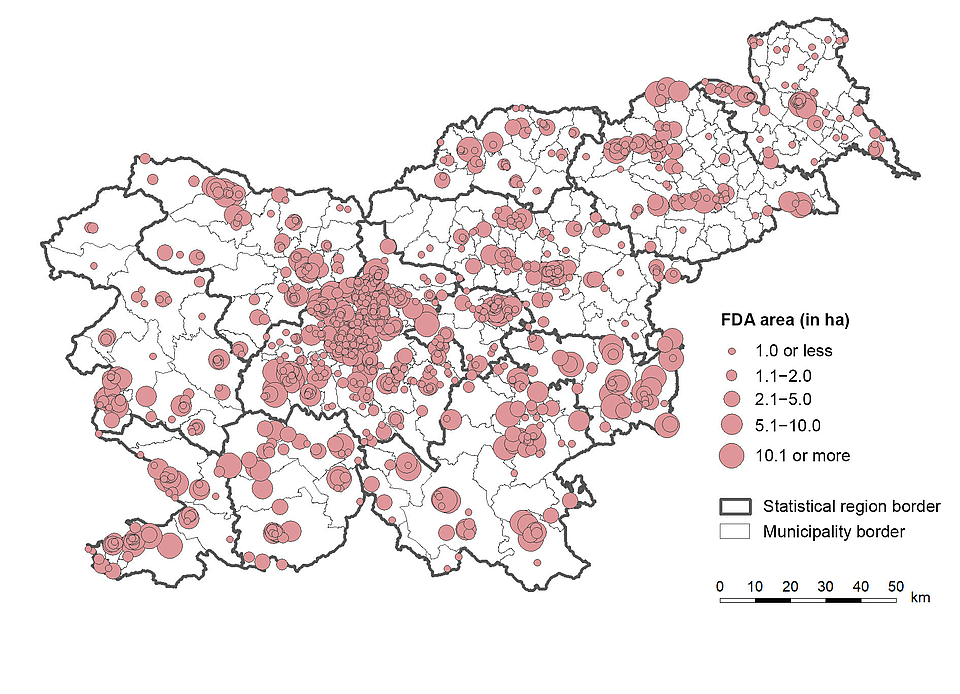
1. Trust in institutions
The level of trust in institutions remains low. It was highest in 2006; since then it has dropped significantly, particularly during the crisis, and is now among the lowest in the EU. Trust in most institutions was the lowest in 2013. Since then it has since been rising, which can be attributed to the improvement in macroeconomic indicators and lower dissatisfaction with the current economic and general situation in Slovenia. The exception is trust in political parties, this improving slightly only in 2017. Of all institutions, political parties are trusted the least, people placing the most trust in local authorities. Despite the improvement in the last few years, trust in all institutions remains lower than the EU average, in contrast to the peak year 2006, when it was higher than in the EU generally. Trust in the government, parliament and political parties is also among the lowest in the EU.
Trust in the EU and its institutions has increased but remains below the EU average. It was the highest in 2006, but since 2008 it has dropped strongly. In 2017 trust in the EU and its main institutions increased slightly relative to 2016. In Slovenia 38% of respondents trust the EU, which is still less than the EU average. Slightly more than one-third of respondents trust the European Parliament, the European Commission and the European Central Bank. All these shares remain lower than the EU average. Despite a decline in their share, as many as 40% of Slovenians still believe that things in the EU are heading in the wrong direction. Respondents in Slovenia see terrorism (46%) and (im)migration (43%) as the two most important issues currently faced by the EU, followed by crime (14%).
Figure: Trust in EU institutions, Slovenia
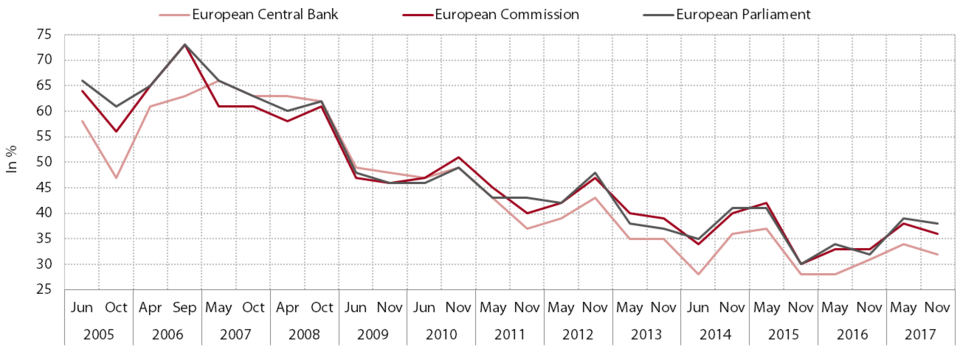
2. Executive capacity
The executive capacity indicator, which measures strategic governance of public institutions, is very low in Slovenia compared with other EU Member States. It is a sustainable governance indicator measuring government and institutional performance in eight dimensions: strategic capacity, inter-ministerial cooperation, regulatory impact assessment, societal consultation, policy communication, implementation of set measures, adaptability and the capacity for reforming public administration. In the last few years its value has been slightly rising, but Slovenia still lags significantly behind the EU average. Its ranking in comparison with other EU Member States remains low and almost unchanged (25th; on the composite sustainable governance index, Slovenia is in 15th place in the EU). Slovenia lags behind the EU as a whole in all index dimensions.
The low executive capacity score is a consequence of inefficient government and institutional performance in several areas. The absence of regulatory impact assessment (RIA) stands out in particular, as no detailed and systematic analyses of potential regulatory impacts on public finances, the economy and society as a whole are yet being carried out. Other factors are the absence of effective strategic planning and the low participation of different expert groups in government decision-making processes; inter-ministerial cooperation is also weak (particularly the participation of the Prime Minister's Office in the preparation of legislation). The assessment of policy implementation at various government levels (both central and local) is also significantly lower than for other EU Member States.
Figure: Indicator of executive capacity by dimension, 2017
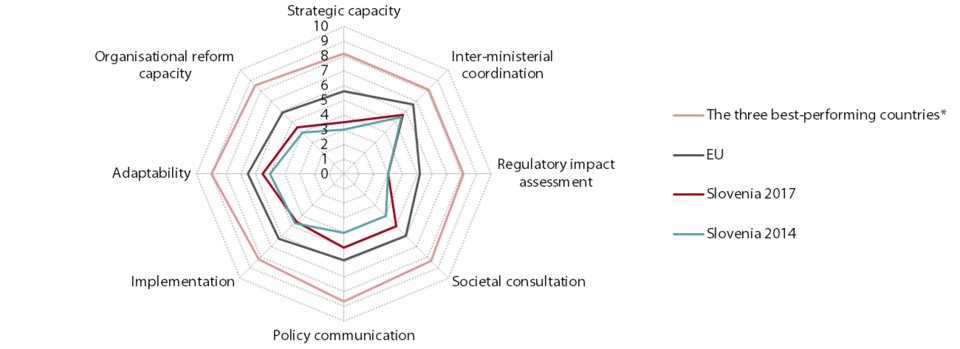
3. Rule of Law Index
Slovenia’s ranking on the Rule of Law Index shows weaknesses in the adherence to the rule of law. The rule of law highlights the principle of equality before the law, emphasising the inviolability of the authority of law and rules. This means that the government respects the law, that the functioning of government bodies is bound by law, and that fundamental human rights and freedoms are ensured. In 2017 Slovenia ranked 15th in the EU according the Rule of Law Index, its ranking not having changed much in the last few years. Adherence to the rule of law is highest in the Scandinavian countries. Index values in the EU are on average significantly higher than elsewhere in the world. Slovenia is ranked around the EU average only in the fundamental rights area, where it scores well on the indicators of absence of discrimination, equal treatment, and freedom of expression and religion. On the other hand, it lags significantly behind the EU particularly in the areas of constraints on government powers, political system and civil justice. The risk of corruption also represents a problem. This reveals weaknesses relating to the adherence to the rule of law (particularly regarding the extent to which government officials are sanctioned for official misconduct), the risk of corruption of officials in the executive and judicial branches of the government, and the duration of legal procedures.
Figure: Rule of Lax Index by sub-components, 2016
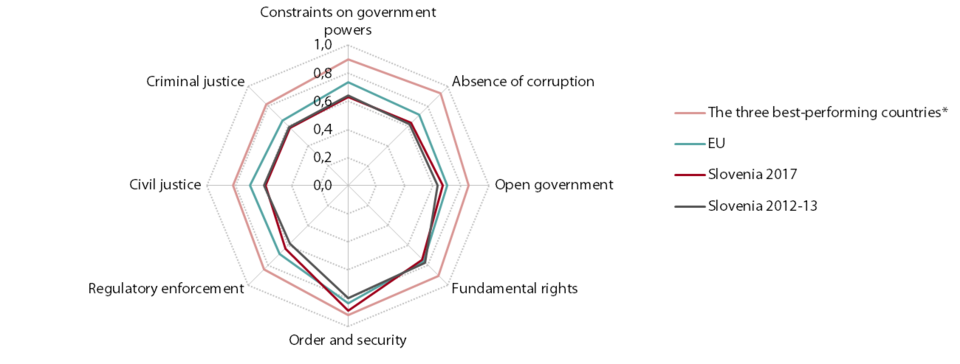
4. Expected time needed to resolve civil litigious and commercial cases
The estimated time needed to resolve civil litigious and commercial cases has been shortening in recent years but remains longer than the EU average. Since 1993 excessive length of proceedings has been one of the human rights violations most frequently found by the European Court of Human Rights. The Court has established that the duration of proceedings can be imputed to the state, as it does not provide conditions for exercising the right to a trial within a reasonable time. By launching the Lukenda Project and adopting structural changes (such as new insolvency legislation), Slovenia implemented a number of measures in this area and shortened the expected duration of civil litigious and commercial cases by around 40% (to 277 days) between 2008 and 2015. The expected length of proceedings indicates the estimated time (in days) needed to resolve a case in court, i.e. the time taken by the court to reach a decision at first instance. Despite the shortening of the length of proceedings, Slovenia still lags behind the EU average. In contrast, administrative cases take only 122 days to resolve, which ranks Slovenia among the most efficient EU Member States (EU average: 414 days). However, owing to the method of its calculation, the expected disposition time does not reflect the time actually taken by the courts. It is also calculated using different data and methodology.
The average actual disposition time for major cases is shortening; in 2017 it was 7.7 months (237 days). This is largely a consequence of a smaller incoming caseload and greater efficiency on the part of the courts: in 2016 the clearance rate for major cases exceeded 100%, which means that the courts are resolving more cases than come in. The number of pending cases is also declining, but the share of pending major cases in the total caseload is increasing (54% in 2016). While it is reasonable to expect that the average time needed to resolve a case will shorten further, it should be borne in mind that excessive shortening of the length of proceedings may be detrimental to the parties concerned (violating their right to be heard, for example) and have a negative effect on the quality of justice (proceedings conducted in a fair and reasonable manner to reach a fair decision). The average time needed to resolve a case totalled 2.6 months.
Figure: Major cases at courts, Slovenia
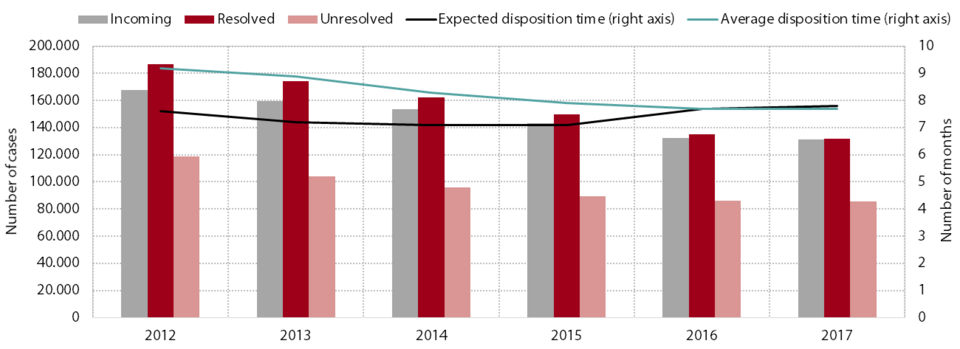
5. Corruption Perception Index
Slovenia is one of the countries where less corruption has been perceived in recent years, but it still lags behind the EU on this indicator. The Corruption Perception Index (CPI) is based on the rate of public sector corruption as perceived by businesspeople, experts and analysts. Between 2011 and 2014, the perceived level of corruption rose significantly in Slovenia, partly owing to the greater exposure of the Commission of the Prevention of Corruption in the media and hence greater awareness of corruption and more corruption cases being reported. The Commission meanwhile finds that the most corruption in the public sector is perceived to exist in public procurement (around 15% of all incidences reported), in administrative procedures, in circumstances that represent a conflict of interest, in procedures regarding the disposal of physical assets owned by the government or municipalities, and in healthcare and pharmacy. Persons most frequently involved in corruptive acts tend to be public servants and officials. In 2017 Slovenia was ranked 31st among 176 countries and 15th in the EU. The level of corruption is lowest in Scandinavian and highest in some Mediterranean Member States (Greece, Spain).
In Slovenia there is a general feeling that corruption is widespread. According to Eurobarometer, 89% of persons asked think that corruption is very common in Slovenia; in the EU as a whole, this share is much smaller (68% of respondents). At the same time, as many as 92% respondents have no experience with corruption. The share of people perceiving corruption has otherwise decreased in the last few years. More than half hold the opinion that corruption is the most widespread in health care and within political parties (58%) and in public procurement (50%). The respondents are mostly dissatisfied with the effectiveness of government measures in this area (74%) and above all believe that high-profile and major cases of corruption are not sanctioned adequately (75%).
Figure: Perception of corruption among the respondents of the Eurobarometer survey
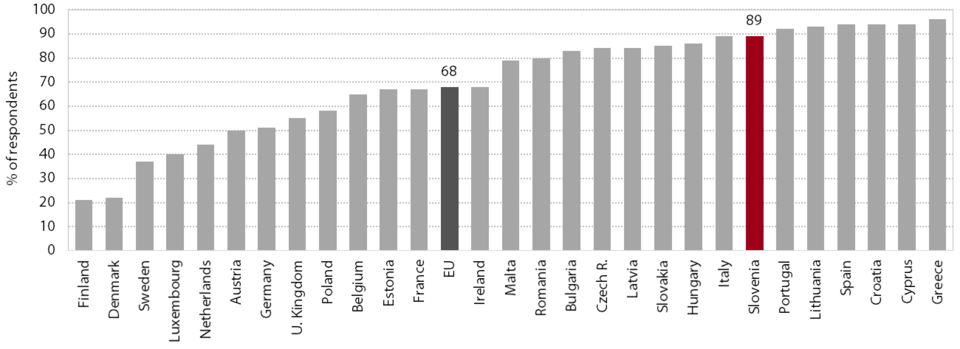
6. Share of households reporting problems with crime, vandalism or violence in the local area
The share of households reporting problems with crime, vandalism or violence in the local area was below the EU average in the last ten-year period. In 2016 it totalled 8.5% and was 4 pps lower than in 2009, when it had been the highest since 2005. Problems with crime, violence or vandalism in the local area were most frequently experienced by single persons with dependent children (12.2%), followed by households of two adults and two children (10.3%), single women (9.9%), and persons older than 65 years (9.8%). All these shares are below the EU average. The share of persons that have problems with crime, vandalism or violence in the local area is lowest in the Pomurska and Zasavska regions (3%) and highest in Jugovzhodna Slovenija and the Osrednjeslovenska regions (13%), where it equals the EU average.
Slovenia remains a safe country compared with other countries in the EU, which has a positive impact on the quality of life. The results of the European Social Survey indicate that 9% of respondents had a personal experience with burglary or physical assault in 2016, which is less than in previous years and lower than the average for countries included in the Social Survey. In 2017, 97% of Slovenians said that their immediate neighbourhood was a secure place to live in; 95% said that Slovenia was a secure place to live in, which is more than in 2015 and more than on average in the EU.
Figure: Crime, vandalism or violence in the local area, 2016
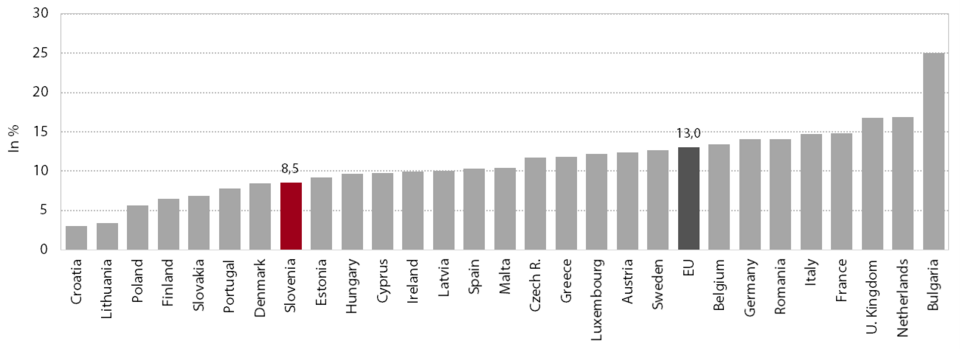
7. Global Peace Index (GPI)
Slovenia is ranked among the most peaceful countries in the world. According to the 2017 GPI, it is in 7th position among 163 countries and 5th among EU Member States. The index value in 2017 was the lowest in ten years, but Slovenia was again ranked higher on the Global Index scale than in the previous five years. While Slovenia is among the 10 best-performing countries in the areas of militarisation, societal safety and security, it ranks lower (66th position) in the domestic and international conflict domain, this owing mainly to the lower scores on the indicators of relations with neighbouring countries and intensity of organised internal conflict. It also scores slightly lower on the number of internal security officers and police per 100,000 people, the level of perceived criminality in society, and the likelihood of violent demonstrations. The Global Peace Index shows that Europe remains the most peaceful region in the world, with eight of the ten most peaceful countries coming from this region (of which six are EU Member States). Iceland remains the most peaceful country in the world and Syria the least. The global index otherwise deteriorated over the ten-year period, primarily owing to the intensifying of conflicts in the Middle East and terrorism.
Figure: Global Peace Index, EU Member States, 2017
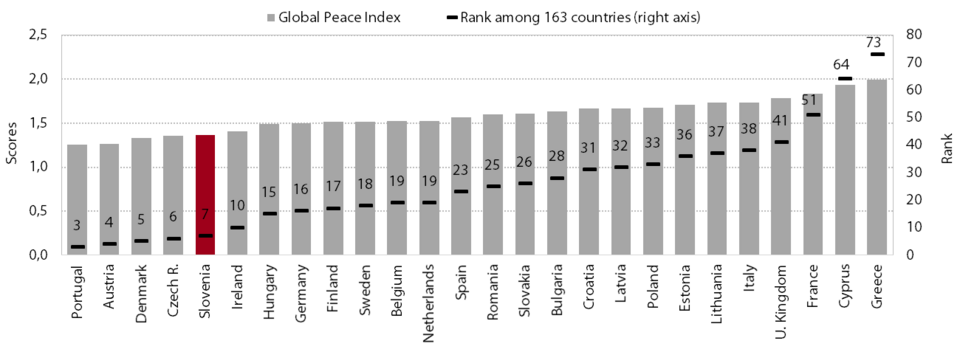
8. Expenditure on official development assistance
Although increasing in recent years, expenditure on official development assistance remains significantly lower than international commitments. Official development assistance is defined as assistance provided by advanced countries to support the sustainable development of developing countries. Slovenia allocated EUR 73.6 million for development assistance in 2016, almost 30% more than in 2015. It dedicates a higher share of gross national income (GNI) for this purpose than most countries that acceded to the EU in 2004 or later. Despite the increase in expenditure, the gap with the EU average has widened and is larger than a decade ago. Official development assistance expenditure still falls considerably short (0.19% of GNI) of international commitments, according to which Slovenia is obliged to increase the share of GNI for official development assistance to 0.33% by 2030.
The bulk of the increase in development assistance in the last few years is related to the refugee and migrant crisis. Development assistance is a sum of multilateral assistance (funding provided for regular development activities of international organisations) and bilateral assistance (where Slovenia, as a donor, has control over the use of donated funds). Two-thirds of assistance is accounted for by multilateral assistance, most of which is dedicated to EU development cooperation programmes. The rest is bilateral assistance, the priority development cooperation regions being the Western Balkans and Turkey, where Slovenia places around 60% of disposable bilateral development aid. In the last decade most of this aid has been focused on projects in the area of social services, particularly in education. Migration developments related to the situation in the Middle East have significantly influenced the structure of assistance in the last two years, which is reflected in increased costs of caring for refugees and migrants in Slovenia, a higher contribution to the EU Facility for Refugees in Turkey, and higher dedicated humanitarian contributions to other international organisations. Expenditure on exemptions from tuition fees for citizens from target countries for study in Slovenia has also increased significantly in this period. Within bilateral development assistance, the share of expenditure on humanitarian and post-conflict aid is declining amid an increase in other expenditures.
Figure: Official development assistance as a share of GNI in EU Member States in 2016, in %
